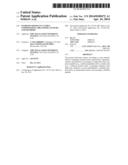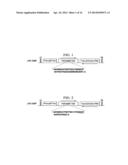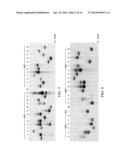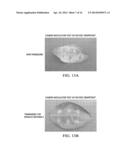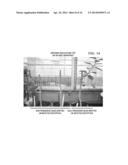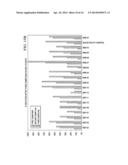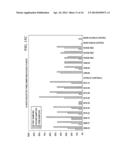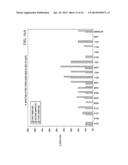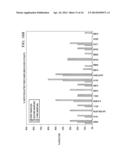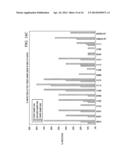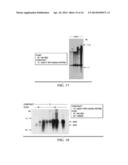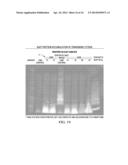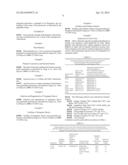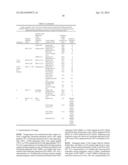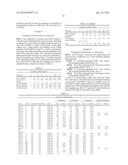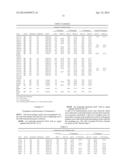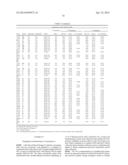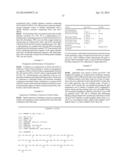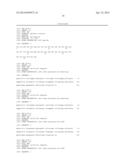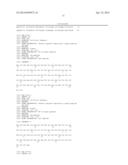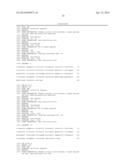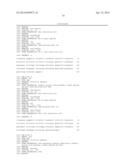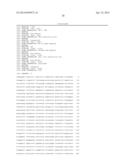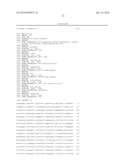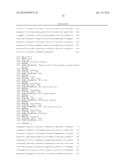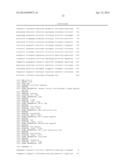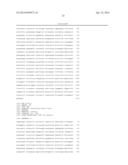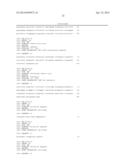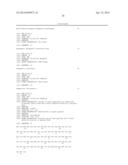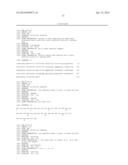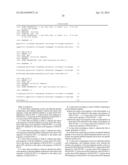Patent application title: PATHOGEN RESISTANT CITRUS COMPOSITIONS, ORGANISMS, SYSTEMS, AND METHODS
Inventors:
T. Erik Mirkov (Harlingen, TX, US)
T. Erik Mirkov (Harlingen, TX, US)
Javier Gonzalez-Ramos (Brownsville, TX, US)
Assignees:
The Texas A&M University System
IPC8 Class: AC12N1582FI
USPC Class:
47 6
Class name: Plant husbandry grafting
Publication date: 2014-04-24
Patent application number: 20140109472
Abstract:
The present disclosure relates, according to some embodiments, to
pathogen resistant citrus compositions, organisms, systems, and methods.
For example, a composition may comprise a peptide (e.g., a defensin
peptide) and/or a nucleic acid (e.g., a defensin nucleic acid). A
pathogen resistant citrus plant may comprise, in some embodiments, a
defensin peptide and/or an expressable nucleic acid encoding a defensin
peptide.Claims:
1. A citrus fruit comprising at least one defensin peptide comprising a
first defensin peptide, wherein the amino acid sequence of the first
defensin peptide is at least about 99% identical to SEQ ID NO: 1, at
least about 99% identical to SEQ ID NO: 2, at least about 99% identical
to SEQ ID NO: 7, or at least about 99% identical to SEQ ID NO: 8.
2. A citrus fruit according to claim 1, wherein the amino acid sequence of the first peptide is at least about 99% identical to the amino acid sequence of SEQ ID NO: 1 or at least about 99% identical to the amino acid sequence of SEQ ID NO: 7.
3. A citrus fruit according to claim 1, wherein the amino acid sequence of the first peptide is identical to the amino acid sequence of SEQ ID NO: 1 or identical to the amino acid sequence of SEQ ID NO: 7.
4. A citrus fruit according to claim 1, wherein the amino acid sequence of the first peptide is at least about 99% identical to the amino acid sequence of SEQ ID NO: 2 or at least about 99% identical to the amino acid sequence of SEQ ID NO: 8.
5. A citrus fruit according to claim 4, wherein the amino acid sequence of the first peptide is identical to the amino acid sequence of SEQ ID NO: 2 or identical to the amino acid sequence of SEQ ID NO: 8.
6. A citrus fruit according to claim 1 further comprising a second defensin peptide, wherein the amino acid sequence of the first peptide is at least about 99% identical to the amino acid sequence of SEQ ID NO: 1 or at least about 99% identical to the amino acid sequence of SEQ ID NO: 7, and wherein the amino acid sequence of the second peptide is at least about 99% identical to the amino acid sequence of SEQ ID NO: 2 or at least about 99% identical to the amino acid sequence of SEQ ID NO: 8.
7. A citrus fruit according to claim 1, wherein the fruit is orange, grapefruit or lemon.
8. A citrus fruit comprising (a) at least one spinich defensin peptide or (b) at least one spinich defensin nucleic acid or (c) at least one spinach defensin peptide and at least one spinich defensin nucleic acid.
9. A citrus fruit comprising at least one defensin nucleic acid comprising a first defensin nucleic acid, wherein the nucleic acid sequence of the first defensin nucleic acid is at least about 98% identical to SEQ ID NO: 3, at least about 98% identical to SEQ ID NO: 4, at least about 98% identical to SEQ ID NO: 5, at least about 98% identical to SEQ ID NO: 6, at least about 98% identical to SEQ ID NO: 9, at least about 98% identical to SEQ ID NO: 10, at least about 98% identical to SEQ ID NO: 11, at least about 98% identical to SEQ ID NO: 12, at least about 98% identical to SEQ ID NO: 30, or at least about 98% identical to SEQ ID NO: 31.
10. A citrus fruit according to claim 9, wherein the nucleic acid sequence of the first nucleic acid is at least about 98% identical to the nucleic acid sequence of SEQ ID NO: 3, at least about 98% identical to the nucleic acid sequence of SEQ ID NO: 5, at least about 98% identical to the nucleic acid sequence of SEQ ID NO: 9, at least about 98% identical to the nucleic acid sequence of SEQ ID NO: 11, or at least about 98% identical to the nucleic acid sequence of SEQ ID NO: 30.
11. A citrus fruit according to claim 10, wherein the nucleic acid sequence of the first nucleic acid is identical to the nucleic acid sequence of SEQ ID NO: 3, identical to the nucleic acid sequence of SEQ ID NO: 5, identical to the nucleic acid sequence of SEQ ID NO: 9, identical to the nucleic acid sequence of SEQ ID NO: 11, or identical to the nucleic acid sequence of SEQ ID NO: 30.
12. A citrus fruit according to claim 9, wherein the nucleic acid sequence of the first nucleic acid is at least about 98% identical to the nucleic acid sequence of SEQ ID NO: 4, at least about 98% identical to the nucleic acid sequence of SEQ ID NO: 6, at least about 98% identical to the nucleic acid sequence of SEQ ID NO: 10, at least about 98% identical to the nucleic acid sequence of SEQ ID NO: 12, or at least about 98% identical to the nucleic acid sequence of SEQ ID NO: 31.
13. A citrus fruit according to claim 12, wherein the nucleic acid sequence of the first nucleic acid is identical to the nucleic acid sequence of SEQ ID NO: 4, identical to the nucleic acid sequence of SEQ ID NO: 6, identical to the nucleic acid sequence of SEQ ID NO: 10, identical to the nucleic acid sequence of SEQ ID NO: 12, or identical to the nucleic acid sequence of SEQ ID NO: 31.
14. A citrus fruit according to claim 9 further comprising a second defensin nucleic acid, wherein the nucleic acid sequence of the first nucleic acid is at least about 98% identical to the nucleic acid sequence of SEQ ID NO: 3, at least about 98% identical to the nucleic acid sequence of SEQ ID NO: 5, at least about 98% identical to the nucleic acid sequence of SEQ ID NO: 9, at least about 98% identical to the nucleic acid sequence of SEQ ID NO: 11 or at least about 98% identical to the nucleic acid sequence of SEQ ID NO: 30, and wherein the nucleic acid sequence of the second nucleic acid is at least about 98% identical to the nucleic acid sequence of SEQ ID NO: 4, at least about 98% identical to the nucleic acid sequence of SEQ ID NO: 6, at least about 98% identical to the nucleic acid sequence of SEQ ID NO: 10, at least about 98% identical to the nucleic acid sequence of SEQ ID NO: 12, or at least about 98% identical to the nucleic acid sequence of SEQ ID NO: 31.
15. A citrus fruit according to claim 9, wherein the fruit is orange, grapefruit or lemon.
16. A citrus composition comprising at least one defensin peptide, wherein the amino acid sequence of the at least one defensin peptide is at least about 99% identical to the amino acid sequence of SEQ ID NO: 1, at least about 99% identical to the amino acid sequence of SEQ ID NO: 2, at least about 99% identical to the amino acid sequence of SEQ ID NO: 7, or at least about 99% identical to the amino acid sequence of SEQ ID NO: 8.
17. A citrus composition according to claim 16, wherein the amino acid sequence is identical to the amino acid sequence of SEQ ID NO: 1, identical to the amino acid sequence of SEQ ID NO: 2, identical to the amino acid sequence of SEQ ID NO: 7 or identical to the amino acid sequence of SEQ ID NO: 8.
18. A citrus composition comprising at least one defensin nucleic acid, wherein the nucleic acid sequence of the at least one nucleic acid is at least about 98% identical to the nucleic acid sequence of SEQ ID NO: 3, at least about 98% identical to the nucleic acid sequence of SEQ ID NO: 4, at least about 98% identical to the nucleic acid sequence of SEQ ID NO: 5, at least about 98% identical to the nucleic acid sequence of SEQ ID NO: 6, at least about 98% identical to the nucleic acid sequence of SEQ ID NO: 9, at least about 98% identical to the nucleic acid sequence of SEQ ID NO: 10, at least about 98% identical to the nucleic acid sequence of SEQ ID NO: 11, at least about 98% identical to the nucleic acid sequence of SEQ ID NO: 12, at least about 98% identical to the nucleic acid sequence of SEQ ID NO: 30, or at least about 98% identical to the nucleic acid sequence of SEQ ID NO: 31.
19. A citrus composition according to claim 18, wherein the nucleic acid sequence of the at least one nucleic acid is identical to the nucleic acid sequence of SEQ ID NO: 3, identical to the nucleic acid sequence of SEQ ID NO: 4, identical to the nucleic acid sequence of SEQ ID NO: 5, identical to the nucleic acid sequence of SEQ ID NO: 6, identical to the nucleic acid sequence of SEQ ID NO: 9, identical to the nucleic acid sequence of SEQ ID NO: 10, identical to the nucleic acid sequence of SEQ ID NO: 11, identical to the nucleic acid sequence of SEQ ID NO: 12, identical to the nucleic acid sequence of SEQ ID NO: 30, or identical to the nucleic acid sequence of SEQ ID NO: 31.
20. A method for grafting a first citrus plant to a second citrus plant, the method comprising: contacting a scion of the first plant with a rootstock of the second plant, wherein the first plant or the second plant comprises an expression cassette, the expression cassette comprising, in a 5' to 3' direction: an expression control sequence, a spinach defensin nucleic acid operably linked to the expression control sequence, wherein the nucleic acid sequence of the spinach defensin is at least about 98% identical to the nucleic acid sequence of SEQ ID NO: 3, at least about 98% identical to the nucleic acid sequence of SEQ ID NO: 4, at least about 98% identical to the nucleic acid sequence of SEQ ID NO: 5, at least about 98% identical to the nucleic acid sequence of SEQ ID NO: 6, at least about 98% identical to the nucleic acid sequence of SEQ ID NO: 9, at least about 98% identical to the nucleic acid sequence of SEQ ID NO: 10, at least about 98% identical to the nucleic acid sequence of SEQ ID NO: 11, at least about 98% identical to the nucleic acid sequence of SEQ ID NO: 12, at least about 98% identical to the nucleic acid sequence of SEQ ID NO: 30, or at least about 98% identical to the nucleic acid sequence of SEQ ID NO: 31, and a 3' termination sequence operably linked to the spinach defensin nucleic acid.
21. A method according to claim 20, wherein the first plant is orange, grapefruit or lemon.
22. A method according to claim 20, wherein the second plant is orange, grapefruit, or lemon.
23. A method according to claim 20, wherein the first plant and the second plant are both orange, grapefruit, or lemon.
24. A method of treating a citrus plant having and/or at risk of having a microbial infection, the method comprising: grafting a second plant to the citrus plant having and/or at risk of having a microbial infection, wherein the second plant comprises an expression cassette, the expression cassette comprising, in a 5' to 3' direction: an expression control sequence, a spinach defensin nucleic acid operably linked to the expression control sequence, wherein the nucleic acid sequence of the spinach defensin is at least about 98% identical to the nucleic acid sequence of SEQ ID NO: 3, at least about 98% identical to the nucleic acid sequence of SEQ ID NO: 4, at least about 98% identical to the nucleic acid sequence of SEQ ID NO: 5, at least about 98% identical to the nucleic acid sequence of SEQ ID NO: 6, at least about 98% identical to the nucleic acid sequence of SEQ ID NO: 9, at least about 98% identical to the nucleic acid sequence of SEQ ID NO: 10, at least about 98% identical to the nucleic acid sequence of SEQ ID NO: 11, at least about 98% identical to the nucleic acid sequence of SEQ ID NO: 12, at least about 98% identical to the nucleic acid sequence of SEQ ID NO: 30, or at least about 98% identical to the nucleic acid sequence of SEQ ID NO: 31, and a 3' termination sequence operably linked to the spinach defensin nucleic acid.
25. A method according to claim 24, wherein the citrus plant having and/or at risk of having a microbial infection is orange, grapefruit, or lemon.
26. A method according to claim 24, wherein the second plant is orange, grapefruit, or lemon.
27. A method according to claim 24, wherein the citrus plant having and/or at risk of having a microbial infection and the second plant are both orange, grapefruit, or lemon.
28. A method for enhancing a citrus plant's innate ability to respond to contact infection with a pathogen, the method comprising: grafting a second plant to the citrus plant, wherein the second plant comprises an expression cassette, the expression cassette comprising, in a 5' to 3' direction: an expression control sequence, a spinach defensin nucleic acid operably linked to the expression control sequence, wherein the nucleic acid sequence of the spinach defensin is at least about 98% identical to the nucleic acid sequence of SEQ ID NO: 3, at least about 98% identical to the nucleic acid sequence of SEQ ID NO: 4, at least about 98% identical to the nucleic acid sequence of SEQ ID NO: 5, at least about 98% identical to the nucleic acid sequence of SEQ ID NO: 6, at least about 98% identical to the nucleic acid sequence of SEQ ID NO: 9, at least about 98% identical to the nucleic acid sequence of SEQ ID NO: 10, at least about 98% identical to the nucleic acid sequence of SEQ ID NO: 11, at least about 98% identical to the nucleic acid sequence of SEQ ID NO: 12, at least about 98% identical to the nucleic acid sequence of SEQ ID NO: 30, or at least about 98% identical to the nucleic acid sequence of SEQ ID NO: 31, and a 3' termination sequence operably linked to the spinach defensin nucleic acid.
29. A method according to claim 27, wherein the citrus plant is orange, grapefruit, or lemon.
30. A method according to claim 27, wherein the second plant is orange, grapefruit, or lemon.
31. A method according to claim 27, wherein the citrus plant and the second plant are both orange, grapefruit, or lemon.
Description:
CROSS-REFERENCE TO RELATED APPLICATIONS
[0001] This application claims priority to U.S. patent application Ser. No. 13/751,936, filed on Jan. 28, 2013, which claims priority from U.S. Provisional Patent Application 61/591,680, filed on Jan. 27, 2012 and U.S. Provisional Patent Application 61/641,641, filed on May 2, 2012. The contents of all of the above are hereby incorporated in their entirety by reference.
FIELD OF THE DISCLOSURE
[0002] The present disclosure relates, in some embodiments, to pathogen resistant citrus compositions, organisms, systems, and methods.
BACKGROUND OF THE DISCLOSURE
[0003] At present, there are no Citrus cultivars resistant to bacterial canker (Xanthomonas axonopodis pv. citri) (Xac), and/or citrus Huanglongbing (ex greening) caused by Candidatus Liberibacter asiaticus (Las). Indeed, no genetic resistance to these microbial pathogens has ever been found within the Citrus genus. Conventional cross-breeding efforts to produce resistant cultivars have been hindered by the complex reproductive biology and long life cycle of Citrus spp.
SUMMARY
[0004] Accordingly, a need has arisen for plants (e.g., citrus) with improved resistance to disease. A further need has arisen for improved methods, compositions, and systems for preparing genetically modified plants (e.g., citrus).
[0005] The present disclosure relates, according to some embodiments, to pathogen resistant citrus compositions, organisms, systems, and methods. For example, a composition may comprise a nucleic acid (e.g., a defensin nucleic acid). In some embodiments, a nucleic acid may comprise a nucleic acid sequence (a) having from about 75% to about 100% identity (e.g., about 98% identity) to a defensin sequence (e.g., SEQ ID NOS: 3, 4, 5, 6, 9, 10, 11, 12, and/or 29) and/or (b) encoding an amino acid sequence having from about 95% to about 100% identity (e.g., 98% identity) to SEQ ID NOS: 1, 2, 7, 8, and/or 28. A nucleic acid may comprise, in some embodiments, a nucleic acid sequence having about 98% identity to a sequence selected from the group consisting of SEQ ID NO: 3 and SEQ ID NO: 5 and encoding a peptide having an amino acid sequence having at least about 99% identity to SEQ ID NO: 1. A nucleic acid may comprise, in some embodiments, a nucleic acid sequence having about 98% identity to a sequence selected from the group consisting of SEQ ID NO: 4 and SEQ ID NO: 6 and encoding a peptide having an amino acid sequence having at least about 99% identity to SEQ ID NO: 2. According to some embodiments, a nucleic acid may comprise a nucleic acid sequence having about 98% identity to a sequence selected from the group consisting of SEQ ID NO: 9 and SEQ ID NO: 11 and encoding a peptide having an amino acid sequence having at least about 99% identity to SEQ ID NO: 7. A nucleic acid may comprise a nucleic acid sequence having about 98% identity to a sequence selected from the group consisting of SEQ ID NO: 10 and SEQ ID NO: 12 and encoding a peptide having an amino acid sequence having at least about 99% identity to SEQ ID NO: 8, in some embodiments.
[0006] The present disclosure relates, in some embodiments, to defensin expression vectors operable in citrus. For example, an expression vector may comprise, in a 5' to 3' direction, (a) an expression control sequence; (b) an expressable nucleic acid (e.g., a nucleic acid encoding an exogenous polypeptide) operably linked to the expression control sequence; and (c) a 3' termination sequence operably linked to the expressable nucleic acid. In some embodiments, an exogenous nucleic acid may comprise a nucleic acid sequence having at least about 75% identity (e.g., at least about 98% identity) to a nucleic acid sequence selected from the group consisting of SEQ ID NO: 3, SEQ ID NO: 4, SEQ ID NO: 5, SEQ ID NO: 6, SEQ ID NO: 9, SEQ ID NO: 10, SEQ ID NO: 11, SEQ ID NO: 12, and SEQ ID NO: 29. An expression vector may be located in a bacterial cell or a plant cell according to some embodiments. An expression vector may comprise, in some embodiments, the nucleotide sequence AACAATGG at positions -4 to 4 relative to a coding sequence (e.g., encoded by an exogenous nucleic acid sequence). According to some embodiments, an expression vector may comprise a linker (e.g., 3' of the expression control sequence and/or 5' of the nucleic acid (e.g., a nucleic acid encoding an exogenous polypeptide) having a length of from about 1 to about 200 nucleotides.
[0007] The present disclosure relates, in some embodiments, to a bacterial cell comprising an expression vector. For example, a bacterial cell may comprise an expression vector comprising, in a 5' to 3' direction, (a) an expression control sequence; (b) an expressable nucleic acid (e.g., a nucleic acid encoding an exogenous polypeptide) operably linked to the expression control sequence; and (c) a 3' termination sequence operably linked to the expressable nucleic acid. A bacterial cell may comprise, for example, an expression vector comprising, in a 5' to 3' direction, (a) an expression control sequence; (b) an exogenous nucleic acid operably linked to the expression control sequence; and/or (c) a 3' termination sequence operably linked to the exogenous nucleic acid, wherein the exogenous nucleic acid comprises a nucleic acid sequence having at least about 98% identity to a nucleic acid sequence selected from the group consisting of SEQ ID NO: 3, SEQ ID NO: 4, SEQ ID NO: 5, SEQ ID NO: 6, SEQ ID NO: 9, SEQ ID NO: 10, SEQ ID NO: 11, and SEQ ID NO: 12.
[0008] The present disclosure relates, in some embodiments, to a plant cell (e.g., a citrus plant cell) comprising an expression vector. For example, a plant cell (e.g., a citrus plant cell) may comprise an expression vector comprising, in a 5' to 3' direction, (a) an expression control sequence; (b) an expressable nucleic acid (e.g., a nucleic acid encoding an exogenous polypeptide) operably linked to the expression control sequence; and (c) a 3' termination sequence operably linked to the expressable nucleic acid. A plant cell (e.g., a citrus plant cell) may comprise, for example, an expression vector comprising, in a 5' to 3' direction, (a) an expression control sequence; (b) an exogenous nucleic acid operably linked to the expression control sequence; and/or (c) a 3' termination sequence operably linked to the exogenous nucleic acid, wherein the exogenous nucleic acid comprises a nucleic acid sequence having at least about 98% identity to a nucleic acid sequence selected from the group consisting of SEQ ID NO: 3, SEQ ID NO: 4, SEQ ID NO: 5, SEQ ID NO: 6, SEQ ID NO: 9, SEQ ID NO: 10, SEQ ID NO: 11, SEQ ID NO: 12, and SEQ ID NO: 29. A plant cell (e.g., a citrus plant cell) may be located in a plant (e.g., a citrus plant) according to some embodiments. Examples of citrus plants include, without limitation, orange and grapefruit. A plant cell may comprise a defensin peptide. A defensin peptide may have, in some embodiments, an amino acid sequence having at least about 99% identity to SEQ ID NO: 1, SEQ ID NO: 2, SEQ ID NO: 7, SEQ ID NO: 8 or SEQ ID NO: 28 (e.g., encoded by and/or expressed from an expression vector nucleic acid) according to some embodiments.
[0009] In some embodiments, the present disclosure relates to a citrus plant (e.g., orange and/or grapefruit) comprising an expression vector. A citrus plant may comprise an expression vector in a single cell, a plurality of cells (e.g., mosaic), or in all cells. A mosaic plant may arise from a graft in some embodiments. For example, a citrus plant may comprise a graft of a transgenic plant having an expression vector in all cells (e.g., scion) and a plant having a different expression vector or no expression vector in its cells (e.g., rootstock). A citrus plant may comprise, in some embodiments, in a single cell, a plurality of cells (e.g., mosaic), or in all cells a first expression vector (e.g., encoding a first defensin peptide) and in a single cell, a plurality of cells (e.g., mosaic), or in all cells a second expression vector (e.g., encoding a second defensin peptide). For example, a citrus plant cell may comprise (a) a first expression vector, the first expression vector comprising, in a 5' to 3' direction, (i) a first expression control sequence; (ii) a first exogenous nucleic acid operably linked to the first expression control sequence; and (iii) a first 3' termination sequence operably linked to the first exogenous nucleic acid, wherein the first exogenous nucleic acid comprises a nucleic acid sequence having at least about 98% identity to a nucleic acid sequence selected from the group consisting of SEQ ID NO: 3, SEQ ID NO: 5, SEQ ID NO: 9, and SEQ ID NO: 11; and (b) a second expression vector, the second expression vector comprising, in a 5' to 3' direction, (iv) a second expression control sequence; (v) a second exogenous nucleic acid operably linked to the second expression control sequence; and (vi) a second 3' termination sequence operably linked to the second exogenous nucleic acid, wherein the second exogenous nucleic acid comprises a nucleic acid sequence having at least about 98% identity to a nucleic acid sequence selected from the group consisting of SEQ ID NO: 4, SEQ ID NO: 6, SEQ ID NO: 10, and SEQ ID NO: 12. According to some embodiments, a citrus plant may comprise in a single cell, a plurality of cells (e.g., mosaic), or in all cells an expression vector comprising a first nucleic acid sequence encoding a first defensin peptide (e.g., SoD2) and a second nucleic acid sequence encoding a second defensin peptide (e.g., SoD7). In some embodiments, a citrus plant may comprise a defensin peptide in a single cell, a plurality of cells (e.g., mosaic), or in all cells. A citrus plant may comprise in a single cell, a plurality of cells (e.g., mosaic), or in all cells a first defensin peptide (e.g., a peptide having at least about 99% identity to SEQ ID NO: 1 or SEQ ID NO: 7) and in a single cell, a plurality of cells (e.g., mosaic), or in all cells a second defensin peptide (e.g., a peptide having at least about 99% identity to SEQ ID NO: 2 or SEQ ID NO: 8).
[0010] The present disclosure relates, in some embodiments, to methods of expressing in a citrus plant an exogenous nucleic acid comprising a nucleic acid sequence encoding an expressed peptide (e.g., a defensin peptide). For example, a method may comprise contacting an expression cassette comprising an exogenous nucleic acid or an expression vector comprising an exogenous nucleic acid with the cytosol of a cell of a citrus plant under conditions that permit expression of the exogenous nucleic acid and formation of the expressed peptide. In some embodiments, an exogenous nucleic acid may comprise a nucleic acid sequence having at least 98% identity to a nucleic acid sequence selected from SEQ ID NO: 3, SEQ ID NO: 4, SEQ ID NO: 5, SEQ ID NO: 6, SEQ ID NO: 9, SEQ ID NO: 10, SEQ ID NO: 11, SEQ ID NO: 12, and/or SEQ ID NO: 29. In some embodiments, an expression vector and/or an expression cassette may comprise, in a 5' to 3' direction, an expression control sequence, the exogenous nucleic acid operably linked to the expression control sequence, and a 3' termination sequence operably linked to the exogenous nucleic acid. An expressed peptide may comprise an amino acid sequence having at least 99% identity to an amino acid sequence selected from SEQ ID NO: 1, SEQ ID NO: 2, SEQ ID NO: 7, SEQ ID NO: 8, and/or SEQ ID NO: 28 according to some embodiments. Contacting an expression vector or cassette may further comprise, in some embodiments, co-cultivating the cell with an Agrobacterium cell comprising the expression vector or expression cassette to form a co-cultivated plant cell. According to some embodiments, a plant may be regenerated from a co-cultivated plant cell.
[0011] The present disclosure relates, in some embodiments, to methods for treating a citrus plant having and/or at risk of having a microbial infection (e.g., bacterial canker (Xanthomonas axonopodis pv. citri) (Xac), and/or citrus Huanglongbing (ex greening) caused by Candidatus Liberibacter asiaticus (Las)). For example, a method may comprise forming in the citrus plant at least one defensin peptide. Forming in the citrus plant at least one defensin peptide may comprise, in some embodiments, grafting the citrus plant with a cutting (e.g., a scion or a rootstock) from a second citrus plant, the second citrus plant comprising an expression vector and/or an expression cassette comprising, in a 5' to 3' direction, an expression control sequence, a defensin nucleic acid operably linked to the expression control sequence, and a 3' termination sequence operably linked to the defensin nucleic acid, wherein the defensin nucleic acid comprises a nucleic acid sequence encoding an amino acid sequence having at least 99% identity to an amino acid sequence selected from SEQ ID NO: 1, SEQ ID NO: 2, SEQ ID NO: 7, SEQ ID NO: 8, and/or SEQ ID NO: 28 under conditions that permit expression of the defensin nucleic acid.
BRIEF DESCRIPTION OF THE DRAWINGS
[0012] The file of this patent contains at least one drawing executed in color. Copies of this patent with color drawing(s) will be provided by the Patent and Trademark Office upon request and payment of the necessary fee.
[0013] Some embodiments of the disclosure may be understood by referring, in part, to the present disclosure and the accompanying drawings, wherein:
[0014] FIG. 1 illustrates an Agrobacterium transformation construct comprising a nucleic acid encoding SoD2 according to specific example embodiments of the disclosure;
[0015] FIG. 2 illustrates an Agrobacterium transformation construct comprising a nucleic acid encoding SoD7 according to specific example embodiments of the disclosure;
[0016] FIG. 3 is a representation of a Southern blot showing insertion number among transgenic events in Hamlin and Rohde Red transformed with a SoD2 (07) nucleic acid comprising a GenScript-optimized sequence for expression in Citrus, according to a specific example embodiment of the disclosure;
[0017] FIG. 4 is a representation of a Southern blot showing insertion number among transgenic events in Hamlin and Rohde Red transformed with SoD2 (09) or SoD7 (10) nucleic acids, each comprising a CODA-optimized sequence for expression in Citrus, according to specific example embodiments of the disclosure;
[0018] FIG. 5 is a representation of a northern blot showing RNA transcripts among transgenic events in Marrs, transformed with SoD2 (07) or SoD7 (08) nucleic acids, each comprising a GenScript-optimized sequence for expression in Citrus, according to a specific example embodiment of the disclosure;
[0019] FIG. 6 is a representation of a northern blot showing RNA transcripts among transgenic events in Hamlin and Rohde Red, transformed with SoD2 (09) or SoD7 (10) nucleic acids, each comprising a CODA-optimized sequence for expression in Citrus, according to a specific example embodiment of the disclosure;
[0020] FIG. 7 is a representation of a northern blot showing RNA transcripts among transgenic events in Hamlin and Rohde Red, transformed with SoD2 (07) or SoD7 (08) nucleic acids, each comprising a GenScript-optimized sequence for expression in Citrus, according to a specific example embodiment of the disclosure;
[0021] FIG. 8 is a representation of a Southern blot confirming insertion of SoD2 or SoD7 in Hamlin plants, transformed with SoD2 (11) or SoD7 (12) nucleic acids, each comprising a DNA 2.0-optimized sequence for expression in Citrus, according to a specific example embodiment of the disclosure;
[0022] FIG. 9 is a representation of a Southern blot confirming insertion of defensins in Ruby Red (01) or Hamlin (04) transformed with SoD2 (09, 11), SoD7 (08, 12), or both SoD2 and SoD7 (13) nucleic acids, each comprising a sequence optimzed for expression in Citrus using a sequence optimization algorithm (GenScript for 08 and 13; Coda for 09, and DNA 2.0 for 11 and 12), according to a specific example embodiment of the disclosure;
[0023] FIG. 10 is a representation of a northern blot showing RNA transcripts among transgenic events in Ruby Red (01) or Hamlin (04), transformed with SoD2 (11), SoD7 (08, 12), or both SoD2 and SoD7 (13) nucleic acids, each comprising a GenScript-optimized sequence (08 and 13) or DNA 2.0-optimized sequence (11 and 12) for expression in Citrus, according to a specific example embodiment of the disclosure;
[0024] FIG. 11 is a representation of a Southern blot confirming insertion of defensins in Carrizo Citrange (CC) transformed with SoD2 (07) or SoD7 (08) nucleic acids, each comprising a GenScript-optimized sequence for expression in Citrus, according to a specific example embodiment of the disclosure;
[0025] FIG. 12 is a representation of a northern blot showing RNA transcripts among transgenic events in Carrizo Citrange (CC) transformed with SoD2 (07) or SoD7 (08) nucleic acids, each comprising a GenScript-optimized sequence for expression in Citrus, according to a specific example embodiment of the disclosure;
[0026] FIG. 13A is a photograph of an excised leaf from a non-transgenic grapefruit tree innoculated with a citrus canker pathogen according to specific example embodiments of the disclosure;
[0027] FIG. 13B is a photograph of an excised leaf from an SoD2 transgenic grapefruit tree innoculated with a citrus canker pathogen according to specific example embodiments of the disclosure;
[0028] FIG. 14 is a photograph of chimeric grapefruit trees resulting from the graft of uninfected, non-transgenic scions on citrus greening infected, non-transgenic rootstocks (left and center) or the graft of uninfected, SoD2 transgenic scions on citrus greening infected, non-transgenic rootstock (right), according to specific example embodiments of the disclosure;
[0029] FIG. 15A illustrates the percentage of Generation 2 citrus plants infected upon the first, second, and third sampling of challenged material, according to specific example embodiments of the disclosure;
[0030] FIG. 15B is a continuation of the bar graph of FIG. 15A illustrating the percentage of Generation 2 citrus plants infected upon the first, second, and third sampling of challenged material, according to specific example embodiments of the disclosure;
[0031] FIG. 15C is a continuation of the bar graph of FIG. 15A illustrating the percentage of Generation 2 citrus plants infected upon the first, second, and third sampling of challenged material, according to specific example embodiments of the disclosure;
[0032] FIG. 16A illustrates the percentage of Generations 2 and 3 citrus plants infected upon the first, second and third samplings of challenged material, according to specific example embodiments of the disclosure;
[0033] FIG. 16B is a continuation of the bar graph of FIG. 16A illustrating the percentage of Generations 2 and 3 citrus plants infected upon the first, second and third samplings of challenged material, according to specific example embodiments of the disclosure;
[0034] FIG. 16C is a continuation of the bar graph of FIG. 16A illustrating the percentage of Generations 2 and 3 citrus plants infected upon the first, second and third samplings of challenged material, according to specific example embodiments of the disclosure; and
[0035] FIG. 17 is a representation of a Southern blot confirming insertion of defensins in Rio Red (01) transformed with both SoD2 and SoD7 (13) nucleic acids, each comprising a GenScript-optimized sequence for expression in Citrus, according to a specific example embodiment of the disclosure;
[0036] FIG. 18 is a representation of a northern blot showing RNA transcripts among transgenic events in Rio Red (01) or Hamlin (04), transformed with both SoD2 and SoD7 (13) nucleic acids, each comprising a GenScript-optimized sequence for expression in Citrus, according to a specific example embodiment of the disclosure; and
[0037] FIG. 19 is a Western blot illustrating binding of an anti-SoD7 according to specific example embodiments of the disclosure to samples containing SoD7.
BRIEF DESCRIPTION OF THE SEQUENCE LISTING
[0038] Some embodiments of the disclosure may be understood by referring, in part, to the present disclosure and the accompanying sequence listing, wherein:
[0039] SEQ ID NO: 1 illustrates an amino acid sequence of a spinach (Spinacia oleracea) defensin (SoD2) according to a specific example embodiment of the disclosure;
[0040] SEQ ID NO: 2 illustrates an amino acid sequence of a spinach (Spinacia oleracea) defensin (SoD7) according to a specific example embodiment of the disclosure;
[0041] SEQ ID NO: 3 illustrates a GenScript-optimized nucleic acid sequence for expression of a spinach (Spinacia oleracea) defensin (SoD2) according to a specific example embodiment of the disclosure;
[0042] SEQ ID NO: 4 illustrates a GenScript-optimized nucleic acid sequence for expression of a spinach (Spinacia oleracea) defensin (SoD7) according to a specific example embodiment of the disclosure;
[0043] SEQ ID NO: 5 illustrates a CODA-optimized nucleic acid sequence for expression of a spinach (Spinacia oleracea) defensin (SoD2) according to a specific example embodiment of the disclosure;
[0044] SEQ ID NO: 6 illustrates a CODA-optimized nucleic acid sequence for expression of a spinach (Spinacia oleracea) defensin (SoD7) according to a specific example embodiment of the disclosure;
[0045] SEQ ID NO: 7 illustrates an amino acid sequence of a chimeric peptide comprising a PR-1b signal peptide and a spinach (Spinacia oleracea) defensin (SoD2) according to a specific example embodiment of the disclosure;
[0046] SEQ ID NO: 8 illustrates an amino acid sequence of a chimeric peptide comprising a PR-1b signal peptide and a spinach (Spinacia oleracea) defensin (SoD7) according to a specific example embodiment of the disclosure;
[0047] SEQ ID NO: 9 illustrates a chimeric nucleic acid sequence comprising a nucleic acd sequence encoding a PR-1b signal peptide and a GenScript-optimized nucleic acid sequence for expression of a spinach (Spinacia oleracea) defensin (SoD2) according to a specific example embodiment of the disclosure;
[0048] SEQ ID NO: 10 illustrates a chimeric nucleic acid sequence comprising a nucleic acd sequence encoding a PR-1b signal peptide and a GenScript-optimized nucleic acid sequence for expression of a spinach (Spinacia oleracea) defensin (SoD7) according to a specific example embodiment of the disclosure;
[0049] SEQ ID NO: 11 illustrates a chimeric nucleic acid sequence comprising a nucleic acd sequence encoding a PR-1b signal peptide and a CODA-optimized nucleic acid sequence for expression of a spinach (Spinacia oleracea) defensin (SoD2) according to a specific example embodiment of the disclosure;
[0050] SEQ ID NO: 12 illustrates a chimeric nucleic acid sequence comprising a nucleic acd sequence encoding a PR-1b signal peptide and a CODA-optimized nucleic acid sequence for expression of a spinach (Spinacia oleracea) defensin (SoD7) according to a specific example embodiment of the disclosure;
[0051] SEQ ID NO: 13 illustrates an expression cassette comprising a nucleic acid sequence encoding a PR-1b signal peptide and a GenScript-optimized nucleic acid sequence for expression of a spinach (Spinacia oleracea) defensin (SoD2) according to a specific example embodiment of the disclosure;
[0052] SEQ ID NO: 14 illustrates an expression cassette comprising a nucleic acid sequence encoding a PR-1b signal peptide and a GenScript-optimized nucleic acid sequence for expression of a spinach (Spinacia oleracea) defensin (SoD7) according to a specific example embodiment of the disclosure;
[0053] SEQ ID NO: 15 illustrates an expression cassette comprising a nucleic acid sequence encoding a PR-1b signal peptide and a CODA-optimized nucleic acid sequence for expression of a spinach (Spinacia oleracea) defensin (SoD2) according to a specific example embodiment of the disclosure;
[0054] SEQ ID NO: 16 illustrates an expression cassette comprising a nucleic acid sequence encoding a PR-1b signal peptide and a CODA-optimized nucleic acid sequence for expression of a spinach (Spinacia oleracea) defensin (SoD7) according to a specific example embodiment of the disclosure;
[0055] SEQ ID NO: 17 illustrates an expression control sequence (CaMV 35S promoter) according to a specific example embodiment of the disclosure;
[0056] SEQ ID NO: 18 illustrates an untranslated region (TEV 5'UTR) according to a specific example embodiment of the disclosure;
[0057] SEQ ID NO: 19 illustrates an expression control sequence (CaMV 35S terminator) according to a specific example embodiment of the disclosure;
[0058] SEQ ID NO: 20 illustrates a nucleic acid sequence of a primer designated Zn5 according to a specific example embodiment of the disclosure;
[0059] SEQ ID NO: 21 illustrates a nucleic acid sequence of a primer designated Zn6 according to a specific example embodiment of the disclosure;
[0060] SEQ ID NO: 22 illustrates a nucleic acid sequence of a primer designated Fcp according to a specific example embodiment of the disclosure;
[0061] SEQ ID NO: 23 illustrates a nucleic acid sequence of a primer designated Rcp according to a specific example embodiment of the disclosure;
[0062] SEQ ID NO: 24 illustrates a nucleic acid sequence of a primer designated GUSF according to a specific example embodiment of the disclosure;
[0063] SEQ ID NO: 25 illustrates a nucleic acid sequence of a primer designated GUSR according to a specific example embodiment of the disclosure;
[0064] SEQ ID NO: 26 illustrates an amino acid sequence of a chimeric peptide comprising a modified PR-1b signal peptide and a GenScript-optimized nucleic acid sequence having a single deletion for expression of a spinach (Spinacia oleracea) defensin (SoD2) according to a specific example embodiment of the disclosure;
[0065] SEQ ID NO: 27 illustrates a chimeric nucleic acid sequence comprising a nucleic acid sequence encoding a modified PR-1b signal peptide and a GenScript-optimized nucleic acid sequence having a single deletion for expression of a spinach (Spinacia oleracea) defensin (SoD2) according to a specific example embodiment of the disclosure;
[0066] SEQ ID NO: 28 illustrates a core amino acid sequence of a defensin according to a specific example embodiment of the disclosure;
[0067] SEQ ID NO: 29 illustrates a nucleic acid sequence for expression of a core defensin according to a specific example embodiment of the disclosure;
[0068] SEQ ID NO: 30 illustrates a DNA 2.0-optimized nucleic acid sequence for expression of a spinach (Spinacia oleracea) defensin (SoD2) according to a specific example embodiment of the disclosure; and
[0069] SEQ ID NO: 31 illustrates a DNA 2.0-optimized nucleic acid sequence for expression of a spinach (Spinacia oleracea) defensin (SoD7) according to a specific example embodiment of the disclosure.
DETAILED DESCRIPTION
[0070] The present disclosure relates, in some embodiments, to compositions, organisms, systems, and methods for enhancing a plant's innate ability, if any, to respond to contact (e.g., infection) with a pathogen (e.g., bacteria, yeast, fungus, virus). In some embodiments, the present disclosure relates to compositions, organisms, systems, and methods for expressing a gene product (e.g., an antimicrobial peptide) in a plant (e.g., citrus). For example, the present disclosure relates to expression control sequences (e.g., promoters), expression cassettes, expression vectors, microorganisms, and/or plants comprising one or more antimicrobial peptides and/or one or more nucleic acids encoding one or more antimicrobial peptides.
I. Compositions
[0071] A. Antimicrobial Peptides
[0072] The present disclosure relates, according to some embodiments, to peptides and/or proteins having insecticidal activity, antimicrobial activity, and/or antiviral activity, which may include, without limitation, avidin, vegetative insecticidal proteins (e.g., Vip3A), insecticidal crystal proteins from Bacillus thuringiensis (e.g., Cry1, Cry1Ab, Cry2, Cry9), pea albumin (e.g., PA1b), hirsutellin A, lectins (e.g., snow drop lily lectin, garlic lectin, onion lectin), amylase inhibitors (e.g., alpha amylase inhibitor), arcelins (e.g., arcelins from beans), proteinase inhibitors, lysozymes (e.g., bovine lysozyme, human lysozyme, mollusk lysozyme), defensin (e.g., SoD2 and/or SoD7), chitinase, β-1,3-glucanase, variants thereof, and/or combinations thereof. An antimicrobial peptide may comprise, for example, one or more antimicrobial-peptides belonging to the family of plant defensins. These polypeptides were originally isolated from spinach leaves (Spinacia oleracea). In some embodiments, a defensin may be small (about 5 kDa), may be basic and/or may be cysteine-rich. In some embodiments, a defensin may comprise a peptide having an amino acid sequence sharing at least about 95% identity, at least about 96% identity, at least about 97% identity, at least about 98% identity, at least about 99% identity, and/or about 100% identity with SEQ ID NO: 1 and/or SEQ ID NO: 2. In some embodiments, an antimicrobial peptide may further comprise one or more amino acids that are independently and/or collectively either neutral (e.g., do not adversely impact antibacterial functionality) and/or augment antibacterial functionality (e.g., by directing the peptide to a desired location (e.g., cellular and/or extracellular). For example, a defensin may comprise a signal peptide derived from the tobacco pathogenesis-related (PR)-1b protein that allows the transport of the peptides into the apoplast of plant cells (e.g., via the secretory pathway) and/or accumulation in the intercellular spaces of leaves, stems, flowers, fruits, seeds, and/or roots. A defensin may comprise, according to some embodiments, a peptide having an amino acid sequence sharing at least about 95% identity, at least about 96% identity, at least about 97% identity, at least about 98% identity, at least about 99% identity, and/or about 100% identity with SEQ ID NO: 7 and/or SEQ ID NO: 8.
[0073] B. Nucleic Acids
[0074] The present disclosure relates, in some embodiments, to nucleic acids (e.g., cassettes, vectors) comprising one or more sequences encoding one or more antimicrobial peptides. For example, a nucleic acid may comprise a cassette comprising a synthetic nucleic acid sequence of SoD2 and/or SoD7 genes. Synthetic SoD2 and/or SoD7 codons may specify the same amino acid sequences as native spinach, having their codons optimized for citrus codon usage. A nucleic acid comprising a SoD2 and/or SoD7 coding sequence may comprise a sequence encoding a signal peptide (e.g., PR-1b). In some embodiments, expression of a nucleic acid comprising a sequence encoding an antimicrobial peptide may be optimized by positioning an initiation codon in a favorable (e.g., optimal) 5' context. According to some embodiments, a nucleic acid may comprise an expression control sequence (e.g., operably linked to a coding sequence). For example, a nucleic acid may comprise a coding gene sequence under the control of a dual enhanced CaMV 35S promoter with a 5' UTR from TEV plant potyvirus (e.g., to provide a translation-enhancing activity to the defensin genes).
[0075] According to some embodiments, a nucleic acid may comprise a nucleotide sequence having at least about 75% identity to SEQ ID NOS: 3, 4, 5, 6, 9, 10, 11, 12, 29, 30, and/or 31, at least about 80% identity to SEQ ID NOS: 3, 4, 5, 6, 9, 10, 11, 12, 29, 30, and/or 29, at least about 85% identity to SEQ ID NOS: 3, 4, 5, 6, 9, 10, 11, 12, 29, 30, and/or 31, at least about 90% identity to SEQ ID NOS: 3, 4, 5, 6, 9, 10, 11, 12, 29, 30, and/or 31, at least about 95% identity to SEQ ID NOS: 3, 4, 5, 6, 9, 10, 11, 12, 29, 30, and/or 31, at least about 97% identity to SEQ ID NOS: 3, 4, 5, 6, 9, 10, 11, 12, 29, 30, and/or 31, at least about 98% identity to SEQ ID NOS: 3, 4, 5, 6, 9, 10, 11, 12, 29, 30, and/or 31, at least about 99% identity to SEQ ID NOS: 3, 4, 5, 6, 9, 10, 11, 12, 29, 30, and/or 31, and/or about 100% identity to SEQ ID NOS: 3, 4, 5, 6, 9, 10, 11, 12, 29, 30, and/or 31. A nucleotide sequence may encode, in some embodiments, an amino acid sequence having at least about 98% identity to SEQ ID NOS: 1, 2, 7, 8, and/or 28, at least about 99% identity to SEQ ID NOS: 1, 2, 7, 8, and/or 28, and/or about 100% identity to SEQ ID NOS: 1, 2, 7, 8, and/or 28. According to some embodiments, a nucleic acid may have a first measure of sequence identity to a reference nucleic acid sequence and may encode an amino acid sequence having a second measure of sequence identity to a reference amino acid sequence. For example, a nucleic acid may have about 85% identity to SEQ ID NOS: 3, 4, 5, 6, 9, 10, 11, 12, 29, 30, and/or 31 and encode an amino acid sequence having about 100% identity with SEQ ID NOS: 1, 2, 7, 8, and/or 28, according to some embodiments.
[0076] A nucleic acid sequence, according to some embodiments, may hybridize to a nucleic acid having the nucleotide sequence of SEQ ID NOS: 3, 4, 5, 6, 9, 10, 11, 12, 29, 30, and/or 31 under stringent conditions. Stringent conditions may include, for example, (a) 4×SSC at 65° C. followed by 0.1×SSC at 65° for 60 minutes and/or (b) 50% formamide, 4×SSC at 65° C. A nucleic acid may comprise a deletion fragment (e.g., a deletion of from about 1 to about 12 bases) of a nucleic acid having a sequence of SEQ ID NOS: 3, 4, 5, 6, 9, 10, 11, 12, 29, 30, and/or 31 that retains antimicrobial activity against at least one microorganism capable of infecting a citrus plant. One of ordinary skill in the art having the benefit of the present disclosure may prepare one or more deletion fragments of a nucleic acid having a sequence of SEQ ID NOS: 3, 4, 5, 6, 9, 10, 11, 12, 29, 30, and/or 31 and screen the resulting fragments for antimicrobial activity against at least one microorganism capable of infecting a citrus plant.
[0077] A nucleic acid sequence having a sequence like SEQ ID NOS: 3, 4, 5, 6, 30, and/or 31 may be identified by database searches using the sequence or elements thereof as the query sequence using the Gapped BLAST algorithm (Altschul et al., 1997 Nucl. Acids Res. 25:3389-3402) with the BLOSUM62 Matrix, a gap cost of 11 and persistence cost of 1 per residue and an E value of 10. Sequence identity may be assessed by any available method according to some embodiments. For example, two sequences may be compared with either ALIGN (Global alignment) or LALIGN (Local homology alignment) in the FASTA suite of applications (Pearson and Lipman, 1988 Proc. Nat. Acad. Sci. 85:2444-2448; Pearson, 1990 Methods in Enzymology 183:63-98) with the BLOSUM50 matrix and gap penalties of -16, -4. Sequence similarity may be assessed according to ClustalW (Larkin et al., 2007, Bioinformatics 23(21): 2947-2948), BLAST, FASTA or similar algorithm.
[0078] C. Expression Cassettes and Vectors
[0079] The disclosure relates, in some embodiments, to expression vectors and/or expression cassettes for expressing a nucleic acid sequence (e.g., a coding sequence) in a cell and comprising an expression control sequence and the nucleic acid sequence operably linked to the expression control sequence. Thus, for example, an expression cassette may comprise a heterologous coding sequence, the expression of which may be desired in a plant.
[0080] 1. Expression Vectors
[0081] The disclosure relates, in some embodiments, to an expression vector which may comprise, for example, a nucleic acid having an expression control sequence and a coding sequence operably linked to the expression control sequence. In some embodiments, an expression control sequence may comprise one or more promoters, one or more operators, one or more enhancers, one or more ribosome binding sites, and/or combinations thereof. An expression control sequence may comprise, for example, a nucleic acid having promoter activity. An expression control sequence, according to some embodiments, may be constitutively active or conditionally active in (a) an organ selected from root, leaf, stem, flower, seed, and/or fruit, and/or (b) active in a tissue selected from epidermis, periderm, parenchyma, collenchyma, sclerenchyma, xylem, phloem, and/or secretory structures. An expression control sequence, according to some embodiments, may be operable to drive expression of a nucleic acid sequence (e.g., a coding sequence) in a cell. Metrics for expression may include, for example, rate of appearance and/or accumulation of a gene product (e.g., RNA and/or protein) and/or total accumulation of a gene product as of one or more time points (e.g., elapsed time after a starting point and/or a stage of development). Comparative assays for gene products may be qualitative, semi-quantitative, and/or quantitative in some embodiments. Comparative assays may indirectly and/or directly assess the presence and/or amount of gene product. In some embodiments, an expression control sequence may be sensitive to one or more stimuli (e.g., one or more small molecules, one or more plant defense-inducing agents, mechanical damage, temperature, pressure). For example, activity of an expression control sequence may be enhanced or suppressed upon infection with a microorganism (e.g., a bacteria or a virus).
[0082] An expression vector may be contacted with a cell (e.g., a plant cell) under conditions that permit expression (e.g., transcription) of the coding sequence. Examples of expression vectors may include the Agrobacterium transformation constructs shown in FIG. 1 and FIG. 2. An expression control sequence may be contacted with a plant cell (e.g., an embryonic cell, a stem cell, a callous cell) under conditions that permit expression of the coding sequence in the cell and/or cells derived from the plant cell according to some embodiments. An expression vector may be contacted with a cell (e.g., a plant cell), in some embodiments, under conditions that permit inheritance of at least a portion of the expression vector in the cell's progeny. According to some embodiments, an expression vector may include one or more selectable markers. For example, an expression vector may include a marker for selection when the vector is in a bacterial host, a yeast host, and/or a plant host.
[0083] 2. Expression Cassettes
[0084] According to some embodiments, the disclosure relates to an expression cassette which may comprise, for example, a nucleic acid having an expression control sequence and a coding sequence operably linked to the expression control sequence. An expression cassette may be comprised in an expression vector. A coding sequence, in some embodiments, may comprise any coding sequence expressible in at least one plant cell. For example, a coding sequence may comprise a plant sequence, a yeast sequence, a bacterial sequence, a viral sequence (e.g., plant virus), an artificial sequence, an antisense sequence thereof, a fragment thereof, a variant thereof, and/or combinations thereof. A coding sequence may comprise, in some embodiments, a sequence encoding one or more gene products with insecticidal, antibacterial, antifungal, antimicrobial, and/or antiviral activity. A coding sequence may comprise, in some embodiments, a start codon, an intron, and/or a translation termination sequence. According to some embodiments, a coding sequence may comprise one or more natural or artificial coding sequences (e.g., encoding a single protein or a chimera). According to some embodiments, an expression cassette may optionally comprise a termination sequence. A coding sequence, in some embodiments, may comprise a sequence at least partially codon optimized for expression in an organism of interest (e.g., a citrus plant).
[0085] An expression control sequence may be used, in some embodiments, to construct an expression cassette comprising, in the 5' to 3' direction, (a) the expression control sequence, (b) a heterologous gene or a coding sequence, or sequence complementary to a native plant gene under control of the expression control sequence, and/or (c) a 3' termination sequence (e.g., a termination sequence comprising a polyadenylation site). Examples of expression cassettes may include, in some embodiments, the cassettes shown in SEQ ID NOS: 13-16. An expression cassette may be incorporated into a variety of autonomously replicating vectors in order to construct an expression vector. An expression cassette may be constructed, for example, by ligating an expression control sequence to a sequence to be expressed (e.g., a coding sequence).
[0086] Some techniques for construction of expression cassettes are well known to those of ordinary skill in the art. For example, a variety of strategies are available for ligating fragments of DNA, the choice of which depends on the nature of the termini of the DNA fragments. An artisan of ordinary skill having the benefit of the present disclosure, a coding sequence (e.g., having antimicrobial activity) and/or portions thereof may be provided by other means, for example chemical or enzymatic synthesis. A nucleic acid may comprise, in a 5' to 3' direction, an expression control sequence, a linker (optional), and a coding sequence according to some embodiments. A nucleic acid may comprise, in some embodiments, one or more restriction sites and/or junction sites between an expression control sequence, a linker, and/or a coding sequence.
II. Microorganisms
[0087] The present disclosure relates, in some embodiments, to a microorganism comprising an antimicrobial peptide (e.g., a heterologous antimicrobial peptide) and/or a nucleic acid (e.g., a heterologous and/or expressible nucleic acid) comprising a nucleic acid sequence encoding an antimicrobial peptide. For example, a microorganism may comprise a bacteria, a yeast, and/or a virus. Examples of microorganisms may include, without limitation, Agrobacterium tumefaciens, Escherichia coli, a lepidopteran cell line, a Rice tungro bacilliform virus, a Commelina yellow mosaic virus, a Banana streak virus, a Taro bacilliform virus, and/or baculovirus. According to some embodiments, an antimicrobial peptide may be tolerated by and/or innocuous to its host microorganism. A microorganism may comprise an expression control sequence and an antimicrobial peptide coding sequence operably linked to the expression control sequence. A nucleic acid (e.g., a heterologous and/or expressible nucleic acid) comprising a nucleic acid sequence encoding an antimicrobial peptide may be present, in some embodiments, on a genomic nucleic acid and/or an extra-genomic nucleic acid.
III. Plants
[0088] The present disclosure relates, in some embodiments, to a plant cell (e.g., an embryonic cell, a stem cell, a callous cell), a tissue, and/or a plant comprising an antimicrobial peptide (e.g., a heterologous antimicrobial peptide) and/or a nucleic acid (e.g., a heterologous and/or expressible nucleic acid) comprising a nucleic acid sequence encoding an antimicrobial peptide. A plant and/or plant cell may be a dicot in some embodiments. Examples of a dicot may include, without limitation, coffee, tomato, pepper, tobacco, lima bean, Arabidopsis, rubber, orange, grapefruit, lemon, lime, tangerine, mandarin, pummelo, potato, squash, peas, and/or sugar beet. A plant cell may be included in a plant tissue, a plant organ, and/or a whole plant in some embodiments. A plant cell in a tissue, organ, and/or whole plant may be adjacent, according to some embodiments, to one or more isogenic cells and/or one or more heterogenic cells. In some embodiments, a plant may include primary transformants and/or progeny thereof. A plant comprising a nucleic acid (e.g., a heterologous and/or expressible nucleic acid) comprising a nucleic acid sequence encoding an antimicrobial peptide may further comprise an expression control sequence operably linked to the nucleic acid, in some embodiments. A nucleic acid sequence encoding an antimicrobial peptide may be expressed, according to some embodiments, in a plant in one or more up to all (e.g., substantially all) organs, tissues, and/or cell types including, without limitation, stalks, leaves, roots, seeds, flowers, fruit, meristem, parenchyma, storage parenchyma, collenchyma, sclerenchyma, epidermis, mesophyll, bundle sheath, guard cells, protoxylem, metaxylem, phloem, phloem companion, and/or combinations thereof. In some embodiments, a nucleic acid and/or its gene product (e.g., an antimicrobial peptide) may be located in and/or translocated to one or more organelles (e.g., vacuoles, chloroplasts, mitochondria, plastids).
IV. Methods
[0089] A. Transforming a Plant
[0090] The present disclosure relates, according to some embodiments, to methods for independent transformation of citrus (e.g., a native genome of a citrus plant). For example, a method may comprise independent transformation, using Agrobacterium tumefaciens (At), of the native genome of the orange (Citrus sinensis) cultivars "Rohde Red", "Hamlin", and/or "Marrs." A transformation method may comprise contacting a nucleic acid comprising a SoD2 and/or SoD7 sequence (e.g., a SoD2 and/or SoD7 synthetic gene sequence) with a citrus plant according to some embodiments. A transformed plant (e.g., a transformed genome of a new orange cultivar) may independently contain, in some embodiments a sequence of a SoD2 gene and/or a SoD7 gene encoding microbial resistance not found within the native gene pool of the Citrus genus. According to some embodiments, a transformed orange cultivar plant may comprise a peptide encoded by a SoD2 gene and/or a SoD7 gene. A transformed plant comprising a sequence of a SoD2 gene and/or a SoD7 gene and/or comprising a peptide encoded by a SoD2 gene and/or a SoD7 gene may display resistance to a range (e.g., a broad range) of bacterial and/or fungal pathogens in some embodiments. For example, a transformed plant comprising a sequence of a SoD2 gene and/or a SoD7 gene and/or comprising a peptide encoded by a SoD2 gene and/or a SoD7 gene may display resistance to bacterial canker (Xanthomonas axonopodis pv. citri) (Xac), and/or citrus Huanglongbing (ex greening) caused by Candidatus Liberibacter asiaticus (Las). See EXAMPLE section below.
[0091] B. Grafting
[0092] The present disclosure relates to grafting at least a portion of a first plant (e.g., a citrus plant) with at least a portion of a second plant (e.g., a citrus plant), according to some embodiments. A first plant may be in any desired condition including, without limitation, a healthy condition, a diseased condition, an injured condition, a stressed condition (e.g., heat, cold, water, and the like), and/or combinations thereof. A first plant may have any desired genotype including, without limitation, wild type, transgenic, mutant, and/or the like with respect to a gene and/or trait of interest.
[0093] A second plant may be in any desired condition including, without limitation, a healthy condition, a diseased condition, an injured condition, a stressed condition (e.g., heat, cold, water, and the like), and/or combinations thereof. A second plant may have any desired genotype including, without limitation, wild type, transgenic, mutant, and/or the like with respect to a gene and/or trait of interest. A first and/or a second plant may comprises at least one antimicrobial peptide and/or at least one nucleic acid comprising a sequence encoding at least one antimicrobial peptide. Where both a first plant comprises at least one antimicrobial peptide and/or at least one nucleic acid comprising a sequence encoding at least one antimicrobial peptide and a second plant comprises at least one antimicrobial peptide and/or at least one nucleic acid comprising a sequence encoding at least one antimicrobial peptide, it may be desirable for the first and second plants to have the same and/or different antimicrobial peptides and/or nucleic acids encoding antimicrobial peptides. Grafting may comprise cutting a portion of a first plant to form a fresh cut site, cutting a portion of a second plant to create a second cut site, and/or contacting a first cut site with a second cut site. A cut site may comprise at least one vascular bundle. Grafting may comprise forming a graft junction and/or, optionally, sealing the graft junction (e.g., by coating the periphery of the graft junction with one or more barrier materials).
[0094] C. Treating Plant Disease
[0095] The present disclosure relates, in some embodiments, to compositions, organisms, systems, and methods for preventing, ameliorating, and/or treating a plant disease (e.g., a citrus disease) and/or at least one symptom of a plant disease. For example, a method may comprise grafting at least a portion of a plant (e.g., a citrus plant) having a plant disease and/or expressing at least one symptom of a plant disease with at least a portion of a plant (e.g., a citrus plant) comprising an antimicrobial peptide. Examples of a plant disease include, without limitation, bacterial canker (Xanthomonas axonopodis pv. citri) (Xac), and/or citrus Huanglongbing (ex greening) caused by Candidatus Liberibacter asiaticus (Las). According to some embodiments, preventing, ameliorating, and/or treating a plant disease (e.g., a citrus disease) and/or at least one symptom of a plant disease may comprise treating and/or curing one or more devastating bacterial diseases of citrus. For example, plants comprising stably integrated SoD2 and SoD7 transgenes in expressible form may display resistance to, without limitation, bacterial canker (Xanthomonas axonopodis pv. citri) (Xac), and/or citrus Huanglongbing (ex greening) caused by Candidatus Liberibacter asiaticus (Las). Such resistance has been observed as described in the Examples below.
[0096] According to some embodiments, the present disclosure relates to compositions, organisms, systems, and methods for augmenting a plant's native resistance to and/or conferring on a plant resistance to a plant disease (e.g., a citrus disease). For example, a method may comprise contacting a plant with an antimicrobial peptide and/or an expressible nucleic acid comprising a nucleic acid sequence encoding an antimicrobial peptide. An expressible nucleic acid comprising a nucleic acid sequence encoding an antimicrobial peptide may be and/or comprise an expression cassette in some embodiments. Contacting may comprise, according to some embodiments, grafting at least a portion of a target plant with a plant comprising an antimicrobial peptide and/or an expressible nucleic acid comprising a nucleic acid sequence encoding an antimicrobial peptide. In some embodiments, contacting may comprise contacting at least a portion of a target plant with a vector (e.g., via Agrobacterium-mediated transformation) comprising an antimicrobial peptide and/or an expressible nucleic acid comprising a nucleic acid sequence encoding an antimicrobial peptide. Examples of a plant disease include, without limitation, bacterial canker (Xanthomonas axonopodis pv. citri) (Xac), and/or citrus Huanglongbing (ex greening) caused by Candidatus Liberibacter asiaticus (Las).
[0097] D. Making a Citrus-Expressible Antimicrobial Peptide
[0098] In some embodiments, the present disclosure relates to compositions, organisms, systems, and methods for forming a citrus-expressible nucleic acid comprising a nucleic acid sequence encoding at least one spinach-derived antimicrobial peptide. For example, a method may comprise identifying an amino acid sequence of an antimicrobial peptide of interest, reverse translating the amino acid sequence to produce a first nucleic acid sequence; codon-optimizing the first nucleic acid sequence for expression in citrus to produce a second nucleic acid sequence, and/or synthesizing a nucleic acid having the second nucleic acid sequence. A method may comprise, in some embodiments, covalently bonding a nucleic acid having the second nucleic acid sequence with one or more nucleic acids having expression control sequences that are operable in citrus in an operable orientation and/or position relative to the nucleic acid having the second nucleic acid sequence.
[0099] As will be understood by those skilled in the art who have the benefit of the instant disclosure, other equivalent or alternative pathogen resistant citrus compositions, organisms, systems, and methods can be envisioned without departing from the description contained herein. Accordingly, the manner of carrying out the disclosure as shown and described is to be construed as illustrative only.
[0100] Persons skilled in the art may make various changes in the shape, size, number, and/or arrangement of parts without departing from the scope of the instant disclosure. For example, the position and number of expression control sequences, coding sequences, linkers, and/or terminator sequences may be varied. Each disclosed method and method step may be performed in association with any other disclosed method or method step and in any order according to some embodiments. Where the verb "may" appears, it is intended to convey an optional and/or permissive condition, but its use is not intended to suggest any lack of operability unless otherwise indicated. Persons skilled in the art may make various changes in methods of preparing and using a composition, device, and/or system of the disclosure. For example, a composition, device, and/or system may be prepared and or used as appropriate for microbial and/or plant (e.g., with regard to sanitary, infectivity, safety, toxicity, biometric, and other considerations). Where desired, some embodiments of the disclosure may be practiced to the exclusion of other embodiments. For example, some polypeptide embodiments may be practiced to the exclusion of a particular amino acid sequence (e.g., SEQ ID NO:26) and/or some nucleic acid embodiments may be practiced to the exclusion of a particular nucleic acid sequence (e.g., SEQ ID NO:27).
[0101] Also, where ranges have been provided, the disclosed endpoints may be treated as exact and/or approximations as desired or demanded by the particular embodiment. Where the endpoints are approximate, the degree of flexibility may vary in proportion to the order of magnitude of the range. For example, on one hand, a range endpoint of about 50 in the context of a range of about 5 to about 50 may include 50.5, but not 52.5 or 55 and, on the other hand, a range endpoint of about 50 in the context of a range of about 0.5 to about 50 may include 55, but not 60 or 75. In addition, it may be desirable, in some embodiments, to mix and match range endpoints. Also, in some embodiments, each figure disclosed (e.g., in one or more of the examples, tables, and/or drawings) may form the basis of a range (e.g., depicted value +/- about 10%, depicted value +/- about 50%, depicted value +/- about 100%) and/or a range endpoint. With respect to the former, a value of 50 depicted in an example, table, and/or drawing may form the basis of a range of, for example, about 45 to about 55, about 25 to about 100, and/or about 0 to about 100.
[0102] These equivalents and alternatives along with obvious changes and modifications are intended to be included within the scope of the present disclosure. Accordingly, the foregoing disclosure is intended to be illustrative, but not limiting, of the scope of the disclosure as illustrated by the appended claims.
EXAMPLES
[0103] Some specific example embodiments of the disclosure may be illustrated by one or more of the examples provided herein.
Example 1
Plant Material
[0104] Plant materials (e.g., Citrus sinensis) were generally prepared for transformation as described by Yang et al., Plant Cell Reports (2000) 19:1203 et seq.
Example 2
Plasmid Construction and Bacterial Strains
[0105] Plasmid construction and bacterial strains were generally performed as described by Yang et al., Plant Cell Reports (2000) 19:1203 et seq.
Example 3
[0106] Agrobacterium Co-Culture and Plant Transformation
[0107] Agrobacterium co-culture and plant transformation were generally performed as described by Yang et al., Plant Cell Reports (2000) 19:1203 et seq.
Example 4
Selection and Regeneration of Transgenic Shoots
[0108] Selection and regeneration of transgenic shoots were generally performed as described by Yang et al., Plant Cell Reports (2000) 19:1203 et seq.
Example 5
Grafting of Transgenic Shoots
[0109] Grafting of transgenic shoots were generally performed as described by Yang et al., Plant Cell Reports (2000) 19:1203 et seq.
Example 6
Southern and Northern Analysis
[0110] Southern and northern analysis were generally performed as described by Yang et al., Plant Cell Reports (2000) 19:1203 et seq.
Example 7
Expression in Citrus Trees
[0111] Table 1 illustrates specific example embodiments of nucleic acid sequences codon-optimized for citrus. Signal peptides and structural gene coding sequences shown are flanked on either side by specific restriction enzyme sites. These sequences were used to construct expression cassettes, vectors, and transformed Agrobacterium for preparation of transgenic plants.
TABLE-US-00001 TABLE 1 Example embodiments of specific nucleotide sequences of antimicrobial genes. The nucleotide sequences were optimized for codon usage in Citrus. Antimicrobial genes specific nucleotide sequences. Source of the The 5' nucleotides include the Optimized cloning site and a preferred Antimicrobial Synthetic Gene context for the start codon. The 3' Gene (code) nucleotides include the cloning site. SoD2 GenScript (07) SEQ ID NO: 9 CODA (09) SEQ ID NO: 11 SoD7 GenScript (08) SEQ ID NO: 10 CODA (10) SEQ ID NO: 12 SoD2 DNA 2.0 (11) SEQ ID NO: 30 SoD7 DNA 2.0 (12) SEQ ID NO: 31 SoD2 + SoD7 GenScript (13) SEQ ID NOS: 9 and 10 SoD2 + SoD7 DNA 2.0 (16) SEQ ID NO: 30 and 31 no SP
[0112] The following cultivars were selected for transformation:
[0113] Orange: Hamlin ("04"), Rohde Red ("05"), and Marrs ("06") (FIGS. 3-7);
[0114] Grapefruit: Ruby Red ("01") (FIGS. 8-11) and Rio Red (Example 14 below);
[0115] Carrizo Citrange ("CC") (FIGS. 12-13);
[0116] Flying Dragon rootstock ("13" and "16");
[0117] Frost Eureka and Frost Lisbon (13'' and "16");
[0118] Swingle rootstock (13'' and "16"); and
[0119] C22 rootstock. Constructs used for each cultivar are shown in Table 2.
TABLE-US-00002
[0119] TABLE 2 Orange, grapefruit, lemon and citrus rootstock cultivars transformed (seedling epicotyls) with three different synthetic sequences of each SoD2 and SoD7 genes encoding antimicrobial peptides from spinach (Spinacia oleracea) (at least 521 events in total). Synthetic Gene Optimized- Transgenic Codon Events Defensin Sequence Codes Number of Synthetic (Sequence Citrus Cultivars (Cultivar and Transgenic Generation Genes Code) (Cultivar Code) Gene) Events 2 (141 SoD2 + SP GenScript (07) Hamlin (04) 0407 14 events) Rohde Red (05) 0507 12 Marrs (06) 0607 6 Carrizo Citrange CC2 18 (CC) CODA (09) Hamlin (04) 0409 16 Rohde Red (05) 0509 6 SoD7 + SP GenScript (08) Hamlin (04) 0408 12 Rohde Red (05) 0508 8 Marrs (06) 0608 7 Carrizo Citrange CC7 29 (CC) CODA (10) Hamlin (04) 0410 5 Rohde Red (05) 0510 8 3 (36 SoD2-no SP DNA 2.0 (11) Hamlin (04) 0411 11 events) Ruby Red (01) 0111 6 SoD7-no SP DNA 2.0 (12) Hamlin (04) 0412 13 Ruby Red (01) 0112 6 4 (187 SoD2 + 7 + SP GenScript (13) Hamlin (04) 413 15 events + Rhode Red (05) 513 14 157 Rio Red (02) 213 18 Swingle Frost Eureka 1013 30 Lemon (10) Frost Lisbon 1113 33 Lemon (11) Swingle Rootstock 1213 157 (12) Flying Dragon 913 46 Rootstock (09) C22 (08) 813 15 Carrizo Citrange 713 16 (07) 4 SoD2 + 7 GenScript Hamlin (04) 0413 15 (07 + 08) Rohde Red (05) 0513 1 Rio Red (02) 0213 7 Carrizo Citrange CC2 + 7 6 (CC) 5 SoD2 + 7-no DNA Hamlin (04) 416 Multiple SP 2.0 (16) GUS positive Plants Frost Eureka 1013 Multiple Lemon (10) GUS positive plants Frost Lisbon 1113 Multiple Lemon (11) GUS positive plants Rhode Red (05) 516 Multiple GUS positive plants
A. Transformation of Orange
[0120] Orange plants were transformed with a single construct comprising GenScript-optimized SoD2 with signal peptide ("07"), GenScript-optimized SoD7 with signal peptide ("08"), CODA-optimized SoD2 with signal peptide ("09"), or CODA-optimized SoD2 with signal peptide ("10"). FIG. 3 is a representation of a Southern blot showing insertion number among transgenic events in Hamlin transformed with GenScript-optimized SoD2 (0407) and Rohde Red transformed with GenScript-optimized SoD2 (0507). FIG. 4 is a representation of a Southern blot showing insertion number among transgenic events in Hamlin transformed with CODA-optimized SoD2 (0409) or CODA-optimized SoD7 (0410) and Rohde Red transformed with CODA-optimized SoD2 (0509) or CODA-optimized SoD7 (0510). Additional tranformation events are shown for GenScript-optimized SoD7 ("08") and CODA-optimized SoD2 ("09") in Hamlin in FIG. 9.
[0121] Transgenic plants of the orange cultivars Hamlin, Rohde Red, and Marrs (n=82) produce high levels of transcripts of these antimicrobial genes (Table 2 and FIGS. 5-7). FIG. 5 is a representation of a northern blot showing RNA transcripts among transgenic events in Marrs, transformed with genes SoD2 (0607) or SoD7 (0608) GenScript-optimized for codon use in Citrus. FIG. 6 is a representation of a northern blot showing RNA transcripts among transgenic events in Hamlin transformed with CODA-optimized SoD2 (0409) or CODA-optimized SoD7 (0410) and Rohde Red transformed with CODA-optimized SoD2 (0509) or CODA-optimized SoD7 (0510). FIG. 7 is a representation of a northern blot showing RNA transcripts among transgenic events in Hamlin transformed with GenScript-optimized SoD2 (0407) or GenScript-optimized SoD7 (0408) and Rohde Red transformed with GenScript-optimized SoD2 (0507) or GenScript-optimized SoD7 (0508). For identification, Table 2 contains the transgenic event codes for cultivar and gene combination.
[0122] Orange plants (Hamlin) were also transformed with a single construct comprising DNA 2.0-optimized SoD2 without signal peptide ("11") or DNA 2.0-optimized SoD7 without signal peptide ("12"). FIG. 8 is a representation of a Southern blot confirming insertion of SoD2 or SoD7 in these orange plants. Additional transformation events are shown for SoD7 (12) in Hamlin in FIG. 9.
B. Transformation of Grapefruit
[0123] Ruby Red ("01") plants were transformed with a single construct comprising DNA 2.0-optimized SoD2 without signal peptide ("11") or DNA 2.0-optimized SoD7 without signal peptide ("12"). FIG. 9 is a representation of a Southern blot (membrane was exposed to probes for both SoD2 and SoD7) confirming insertion of SoD2 or SoD7 in these grapefruit plants. FIG. 10 is a representation of a northern blot (membrane was exposed to probes for both SoD2 and SoD7) showing RNA transcripts among transgenic events in Ruby Red transformed with SoD2 (0111) or SoD7 (0112). For identification, Table 2 contains the transgenic event codes for cultivar and gene combination.
C. Transformation of Carrizo Citrange and C22
[0124] Carrizo Citrange and C22 rootstocks have been transformed with a construct comprising uidA and either SoD2 or SoD7 or SoD2+SoD7. FIG. 11 is a representation of a Southern blot confirming insertion of SoD2 (lanes marked "07") and SoD7 (lanes marked "08") in these Carrizo Citrange plants. FIG. 12 is a representation of a northern blot showing RNA transcripts isolated from these Carrizo Citrange plants (marked "CC") transformed with SoD2 (GenScript-optimized sequence with signal peptide) and SoD7 (GenScript-optimized sequence with signal peptide). For identification, Table 2 contains the transgenic event codes for cultivar and gene combination. A number of C22 transformation events have been confirmed in each by positive GUS staining
[0125] Swingle and Flying Dragon (citrus rootstock) plants were transformed with various constructs including a single construct comprising GenScript-optimized SoD2 and SoD7 with signal peptide. Successful tranformation of C22, Flying Dragon, and Swingle plants has been at least confirmed by positive GUS staining
D. Transformation of Lemon
[0126] Frost Lisbon and Frost Eureka (lemon) plants were transformed with various constructs including a single construct comprising GenScript-optimized SoD2 and SoD7 with signal peptide. Successful tranformation of C22, Flying Dragon, and Swingle plants has been at least confirmed by positive GUS staining.
Example 8
Canker Disease Resistance Assay
[0127] Canker disease resistance was assessed using a detached leaf assay generally as described by Francis M I et al., 2010, Eur J Plant Pathol 127:571-578. Briefly, detached immature leaves (˜75% expanded) were triple rinsed in sterile water to remove debris, sanitized by brief immersion in 70% ethanol followed by 0.5% sodium hypochloride, and again triple rinsed in sterile water. Sanitized leaves (3-4 per replicate×3 replicates) were infiltrated on their abaxial surface with an aqueous suspension of an Xcc strain isolated in Dade County Florida. Innoculated leaves were pressed on the surface of soft water agar plates, parafilm sealed, and incubated in an environmentally-controlled growth chamber.
[0128] FIG. 13A shows the result of inoculating a non-transgenic `Rio Red` leaf with the citrus canker pathogen, as described above, and FIG. 13B shows the result of inoculating a transgenic leaf from a plant of `Rio Red` expressing SoD2 with the citrus canker pathogen, as described above. A large reduction in the size and number of lesion on the transgenic can be seen.
Example 9
Citrus Greening (HLB) Disease Resistance Assay by Grafting
[0129] FIG. 14 shows the result of graft inoculating non-transgenic `Rio Red` (two trees on the left) or transgenic `Rio Red` expressing SoD2 one tree on the right) with the citrus greening pathogen. A non-transgenic rootstock (Cleopatra mandarin) infected with HLB is used. Onto this rootstock several buds of transgenic `Rio Red` are grafted and this is replicated. The same protocol is followed for non-transgenic buds of `Rio Red`. After 8 weeks, vigorous growth can be seen from the transgenic graft, where there is no growth on the controls.
Example 10
Citrus Greening (HLB) Disease Resistance Assay by Psyllid Inoculation
[0130] Resistance to bacterial infection and growth was assessed by two metrics. First, resistance was evaluated by the percentage of infection, namely the number of exposed plants that were infected. Second, a PCR-based method was used to amplify bacterial sequences. In this method, the relative degree of infection influences the number of PCR cycles required to produce detectable signal. For example a heavily infested plant might only require a few cycles while a plant with a low bacterial titer may require more cycles. In general, a plant that requires 30 or more cycles to observe detectable signal is regarded to be uninfected. Since some infections of citrus progress slowly, samples were collected for testing at 5 to 11 months after the time of first exposure and thereafter over a period of 6-9 months. The frequency of sample collection may vary from about every 45 days to about every 120 days. Ten to 15 replicates of each transgenic event plus non-transgenic controls are placed haphazardly in an insect proof green house that contains thousands' of psyllids carrying the citrus greening pathogen. The first PCR testing is done about five months after continuous exposure to psyllids. DNA extraction and PCR to detect the pathogen is essentially as described by Irey M S et al., 2006, Proc. Fla. State Hort. Soc. 119:89-93.
Example 11
Propagation and Resistance of Generation 1
[0131] Red Grapefruit (2 varieties) and Sweet Orange (3 varieties) were transformed with Agrobacterium comprising an expression vector having an artificial defensin gene construct that included a 2-amino acid insertion in the signal peptide and a single amino acid deletion in the coding sequence (SEQ ID NOS: 26 and 27). A total of 6 transformation events were further tested based on having high levels of SoD2 RNA expressed. Plants were cultivated as described herein and bacterial resistance was assessed as described. A first set of samples were collected after 11 months in the field (D0). Subsequent samples were collected the indicated number of days (42-471) after the first sampling (e.g., D42=11 months+42 days). Results are shown in Table 3.
TABLE-US-00003 TABLE 3 Generation 1 Infection Data Plant Line N 0 42 90 127 271 384 471 GR 311 Hamlin 1 0% 0% 0% 0% 100% 100% 100% Non Transgenic 1 0% 0% 100% 100% 100% 100% 100% Hamlin GR 420 Grapefruit 1 0% 0% 0% 0% 0% 100% 100% GR 824 Grapefruit 2 0% 0% 50% 50% 100% 100% 100% GR 867 Grapefruit 1 0% 0% 0% 0% 100% 100% 100% GR 882 Grapefruit 2 0% 0% 0% 50% 50% 50% 50% GR 890 Grapefruit 1 0% 0% 0% 0% 0% 100% 100% Non Transgenic 7 0% 0% 0% 14% 0% 57% 57% Grapefruit Non Transgenic 6 0% 0% 0% 0% 50% 50% 50% Grapefruit Border Total 22 0% 0% 9% 18% 41% 68% 68%
Example 12
Propagation and Resistance of Generation 2
[0132] Sweet Orange (2 varieties) were transformed with Agrobacterium comprising one of the following defensin gene constructs:
[0133] (a) GenScript-optimized SoD2 with tobacco PR-1b signal peptide (SEQ ID NO: 9),
[0134] (b) CODA-optimized SoD2 with tobacco PR-1b signal peptide (SEQ ID NO: 11),
[0135] (c) GenScript-optimized SoD7 with tobacco PR-1b signal peptide (SEQ ID NO: 10), or
[0136] (d) CODA-optimized SoD7 with tobacco PR-1b signal peptide (SEQ ID NO: 12). A total of 71 transformation events were observed. Plants were cultivated as described herein and bacterial resistance was assessed as described. A first set of samples were collected after 5 months in the psyllid house (Day 0). Subsequent samples were collected the indicated number of days after the first sampling (e.g., Day 73=5 months+73 days). Results are shown in FIG. 15, FIG. 16, Table 4, and Table 5.
TABLE-US-00004
[0136] TABLE 4 Generation 2 Infection Data 1st Sampling 2nd Sampling 3rd Sampling Partial 4th Sampling Code Scion1 Genotype2 Rootstock3 Gene4 Day 0 Mean Ct Day 73 Mean Ct Day 170 Mean Ct Day 317 Mean Ct 0407-01 H SO Cm SoD2 (G) 13% 23.02 33% 26.09 33% 23.28 0407-02 H SO Cm SoD2 (G) 0% 27% 28.78 47% 26.55 0407-03 H SO Cm SoD2 (G) 0% 7% 24.84 33% 29.32 0407-04 H SO Cm SoD2 (G) 20% 25.56 27% 27.18 40% 25.28 0407-06 H SO Cm SoD2 (G) 7% 31.07 7% 26.16 13% 22.52 67% 28.81 0407-07 H SO Cm SoD2 (G) 20% 27.37 13% 25.96 27% 25.85 80% 27.26 0407-09 H SO Cm SoD2 (G) 13% 26.05 27% 26.83 33% 22.90 0407-10 H SO Cm SoD2 (G) 7% 23.57 27% 26.04 47% 25.32 0407-11 H SO Cm SoD2 (G) 7% 26.75 33% 26.21 67% 24.87 0407-12 H SO Cm SoD2 (G) 7% 31.66 13% 24.51 33% 23.39 0407-13 H SO Cm SoD2 (G) 13% 23.52 27% 27.89 40% 23.54 0408-01 H SO Cm SoD7 (G) 13% 24.88 27% 25.55 53% 26.15 0408-07A H SO Cm SoD7 (G) 7% 23.40 20% 28.48 27% 22.64 80% 27.08 Hamlin H SO Cm Control 0% 20% 28.83 40% 24.59 87% 25.92 NT Control 0409-02 H SO Cm SoD2 (C) 7% 27.34 0% 20% 24.04 80% 26.23 0409-03 H SO Cm SoD2 (C) 7% 22.28 7% 28.79 27% 22.12 93% 25.52 0409-06 H SO Cm SoD2 (C) 0% 20% 26.52 40% 24.01 0409-07 H SO Cm SoD2 (C) 0% 20% 26.31 40% 23.17 0410-01 H SO Cm SoD7 (C) 0% 40% 22.96 73% 24.78 0507-01 RR SO Cm SoD2 (G) 0% 47% 26.35 60% 23.60 0507-02 RR SO Cm SoD2 (G) 13% 28.26 40% 22.18 47% 25.14 0507-03 RR SO Cm SoD2 (G) 13% 24.61 47% 26.64 60% 23.59 0507-04 RR SO Cm SoD2 (G) 13% 26.21 27% 25.25 40% 24.63 0507-07 RR SO Cm SoD2 (G) 0% 13% 27.42 27% 22.61 67% 29.19 0507-08 RR SO Cm SoD2 (G) 7% 25.97 40% 26.37 40% 24.03 0507-10 RR SO Cm SoD2 (G) 7% 26.04 27% 25.71 40% 25.29 0507-11 RR SO Cm SoD2 (G) 0% 40% 26.51 53% 22.26 0507-12 RR SO Cm SoD2 (G) 0% 20% 17.61 13% 22.56 77% 27.17 0507-15 RR SO Cm SoD2 (G) 13% 24.49 53% 25.65 73% 23.10 0508-02 RR SO Cm SoD7 (G) 13% 29.40 47% 26.25 73% 23.90 0508-03 RR SO Cm SoD7 (G) 7% 31.44 33% 24.53 60% 25.43 0508-04 RR SO Cm SoD7 (G) 13% 25.65 20% 28.00 60% 25.74 0508-06 RR SO Cm SoD7 (G) 0% 7% 27.72 27% 24.33 79% 25.56 0508-07 RR SO Cm SoD7 (G) 27% 26.86 67% 25.30 100% 24.76 100% 21.87 0508-08 RR SO Cm SoD7 (G) 7% 24.35 27% 24.55 53% 23.07 0508-09 RR SO Cm SoD7 (G) 20% 25.55 33% 24.69 60% 24.40 0508-10 RR SO Cm SoD7 (G) 7% 25.96 33% 25.94 47% 23.30 Rohde RR SO Cm Control 13% 27.03 27% 25.64 67% 25.46 100% 22.32 Red NT Control 0509-02 RR SO Cm SoD2 (C) 13% 24.36 53% 23.07 60% 23.77 0509-03 RR SO Cm SoD2 (C) 13% 25.28 27% 26.60 53% 26.02 0509-07 RR SO Cm SoD2 (C) 7% 30.19 20% 24.85 47% 25.71 0509-10 RR SO Cm SoD2 (C) 20% 27.29 20% 24.93 67% 26.26 0510-02 RR SO Cm SoD7 (C) 7% 30.66 27% 23.36 47% 24.42 0510-03 RR SO Cm SoD7 (C) 7% 22.01 20% 24.70 53% 25.39 0510-05 RR SO Cm SoD7 (C) 7% 31.54 7% 31.03 7% 31.22 17% 35.78 0510-06 RR SO Cm SoD7 (C) 0% 33% 26.56 80% 24.48 93% 23.67 0510-08 RR SO Cm SoD7 (C) 7% 23.07 47% 25.29 60% 22.32 0510-09 RR SO Cm SoD7 (C) 0% 33% 24.63 47% 24.02 0510-10 RR SO Cm SoD7 (C) 0% 20% 27.68 60% 25.16 Extra NT Controls Hamlin H SO Cm Control 0% 40% 27.29 47% 23.25 Hamlin H SO Cm Control 7% 24.49 13% 24.87 33% 25.58 Hamlin H SO Cm Control 0% 33% 24.44 33% 25.82 Rohde RR SO Cm Control 7% 24.61 33% 26.27 27% 22.98 Red Rohde RR SO Cm Control 0% 40% 27.07 33% 24.49 Red Rohde RR SO Cm Control 7% 24.36 33% 29.01 47% 26.50 Red 1H = Hamlin; RR = Rohde Red 2SO = Sweet Orange 3Cm = Cleopatra mandarin 4(G) = GenScript-optimized sequence; (C) = CODA-optimized sequence
Example 13
Propagation and Resistance of Generation 3
[0137] One Sweet Orange variety and one grapefruit variety were transformed with Agrobacterium comprising one of the following defensin gene constructs:
[0138] (a) GenScript-optimized SoD2 with no signal peptide (SEQ ID NO: 3), or
[0139] (b) GenScript-optimized SoD7 with no signal peptide (SEQ ID NO: 4). A total of 36 transformation events were observed. Plants were cultivated as described herein and bacterial resistance was assessed as described. A first set of samples were collected after 5 months in the psyllid house (Day 0). Subsequent samples were collected the indicated number of days after the first sampling (e.g., Day 103=5 months+103 days). Results are shown in FIG. 16 and Table 5.
TABLE-US-00005
[0139] TABLE 5 Generations 2 and 3 Infection Data 1st Sampling 2nd Sampling 3rd Sampling Code Scion1 Genotype2 Rootstock3 Gene4 Day 0 Day 103 Avg Ct Ct of Positive Day 215 Avg Ct Ct of Positive 41103 H SO Cm SoD2 (-P) 10% 10% 37.98 24.78 10% 36.83 19.62 41108 H SO Cm SoD2 (-P) 0% 0% 40.00 0% 38.93 41107 H SO Cm SoD2 (-P) 10% 14% 37.24 23.44 14% 35.28 21.02 41110 H SO Cm SoD2 (-P) 0% 10% 38.18 26.35 20% 35.24 23.33 40918 H SO Cm SoD2 (C) 0% 0% 39.74 10% 36.97 21.53 40915 H SO Cm SoD2 (C) 0% 11% 38.07 25.22 22% 34.31 24.44 41004 H SO Cm SoD7 (C) 0% 10% 38.37 23.72 20% 35.24 25.54 40814 H SO Cm SoD7 (G) 0% 20% 36.62 26.39 10% 36.85 24.35 40817 H SO Cm SoD7 (G) 10% 10% 37.97 22.93 30% 34.17 23.40 11206 RR Gf Cm SoD7 (-P) 0% 30% 35.18 23.93 40% 32.27 24.69 11204 RR Gf Cm SoD7 (-P) 0% 10% 37.63 24.56 30% 33.49 22.16 40813 H SO Cm SoD7 (G) 10% 11% 37.73 22.63 44% 31.96 22.62 11201 RR Gf Cm SoD7 (-P) 0% 30% 35.87 26.76 30% 33.71 23.06 41109 H SO Cm SoD2 (-P) 0% 10% 38.46 24.64 10% 37.25 22.14 11208 RR Gf Cm SoD7 (-P) 0% 0% 39.82 0% 38.42 11108 RR Gf Cm SoD2 (-P) 0% 0% 38.60 13% 36.15 21.66 11103 RR Gf Cm SoD2 (-P) 0% 20% 36.98 26.00 20% 33.73 19.99 60811 M SO Cm SoD7 (G) 0% 0% 39.66 0% 39.03 Marrs M SO Cm Control 0% 10% 38.81 28.14 20% 35.57 24.93 WT 40820 H SO Cm SoD7 (G) 10% 20% 36.99 25.96 30% 34.94 23.65 41101 H SO Cm SoD2 (-P) 0% 10% 37.65 23.09 20% 34.53 21.92 Ruby RR Gf Cm Control 0% 0% 39.39 30% 34.88 26.93 Red WT 11105 RR Gf Cm SoD2 (-P) 0% 10% 38.64 26.38 20% 36.32 24.70 40810 H SO Cm SoD7 (G) 0% 25% 35.46 24.94 50% 30.83 23.08 A 11203 RR Gf Cm SoD7 (-P) 0% 20% 37.84 29.19 20% 35.55 21.51 40914 H SO Cm SoD2 (C) 0% 0% 39.66 30% 35.22 26.78 40812 H SO Cm SoD7 (G) 0% 10% 37.99 27.44 20% 35.67 21.75 41102 H SO Cm SoD2 (-P) 10% 40% 35.03 27.58 60% 29.83 23.83 Hamlin H SO Cm Control 0% 40% 33.76 24.41 50% 29.52 22.14 WT 60813 M SO Cm SoD7 (G) 0% 0% 40.00 13% 37.06 24.02 60804 M SO Cm SoD7 (G) 10% 0% 39.80 0% 37.74 60703 M SO Cm SoD2 (G) 0% 33% 36.35 30.88 33% 36.07 25.07 60802 M SO Cm SoD7 (G) 0% 0% 39.18 10% 37.87 31.23 60702 M SO Cm SoD2 (G) 0% 10% 38.30 27.16 20% 35.46 24.11 41211 H SO Cm SoD7 (-P) 10% 20% 36.47 24.33 30% 34.02 21.20 41203 H SO Cm SoD7 (-P) 0% 0% 39.93 0% 38.17 60812 M SO Cm SoD7 (G) 0% 0% 40.00 10% 36.79 23.40 60810 M SO Cm SoD7 (G) 10% 20% 37.25 26.25 70% 27.87 23.44 60707 M SO Cm SoD2 (G) 0% 10% 38.51 25.13 40% 33.77 25.40 60701 M SO Cm SoD2 (G) 0% 20% 37.45 28.07 50% 30.37 23.85 41210 H SO Cm SoD7 (-P) 0% 0% 39.60 20% 34.62 22.91 41202 H SO Cm SoD7 (-P) 10% 17% 35.89 23.81 50% 30.85 22.69 60706 M SO Cm SoD2 (G) 0% 10% 37.64 25.23 50% 30.82 23.24 41209 H SO Cm SoD7 (-P) 0% 40% 33.36 24.97 70% 27.11 22.03 41113 H SO Cm SoD2 (-P) 20% 60% 31.02 25.03 80% 25.36 21.70 41215 H SO Cm SoD7 (-P) 20% 40% 33.73 24.32 70% 25.95 21.94 60808 M SO Cm SoD7 (G) 0% 0% 39.35 22% 36.32 22.11 41208 H SO Cm SoD7 (-P) 0% 0% 39.62 11% 37.30 22.04 41112 H SO Cm SoD2 (-P) 20% 20% 35.94 25.32 40% 31.22 22.22 41214 H SO Cm SoD7 (-P) 0% 20% 36.57 24.47 50% 29.72 21.99 60705 M SO Cm SoD2 (G) 0% 10% 37.96 23.82 10% 36.57 21.02 41204 H SO Cm SoD7 (-P) 0% 0% 40.00 10% 36.50 22.28 41111 H SO Cm SoD2 (-P) 10% 13% 37.98 23.82 25% 35.18 24.46 Hamlin H SO Cm Control 0% 25% 35.56 26.41 55% 29.82 22.51 WT Marrs M SO Cm Control 0% 0% 39.16 33% 33.11 22.73 WT 1H = Hamlin; RR = Ruby Red; M = Marrs 2SO = Sweet Orange; Gf = Grapefruit 3Cm = Cleopatra mandarin 4(G) = GenScript-optimized sequence; (C) = CODA-optimized sequence; (-P) = DNA 2.0-optimized sequence with no signal peptide
Example 14
Propagation and Resistance of Generation 4
[0140] A first line of Sweet Orange (2 varieties), one grapefruit, and two rootstocks were prepared to co-express (i) GenScript SoD2 with tobacco PR-1b signal peptide (SEQ ID NO: 9) and (ii) GenScript SoD7 with tobacco PR-1b signal peptide (SEQ ID NO: 10). More specifically, plants were transformed with a double defensin construct comprising, in a 5' to 3' direction SoD2, uidA, and SoD7 (13). A total of 29 transformation events were observed with another 28 GUS-positive candidates in tissue culture or just out of tissue culture. Plants confirmed to co-express SoD2 and SoD7 will be cultivated and evaluated in infection assays to determine the degree to which coexpression prevents, ameliorates, and/or treats infection.
[0141] FIG. 9 is a representation of a Southern blot (membrane was exposed to probes for both SoD2 and SoD7) showing insertion number among transgenic events in Hamlin transformed with a double defensin construct comprising SoD2 and SoD7 (0413). FIG. 10 also shows insertion number among transgenic events in Hamlin transformed with a double defensin construct comprising SoD2 and SoD7 (0413).
[0142] Rio Red plants (02) were transformed with a double defensin construct (13). FIG. 17 is a representation of a Southern blot confirming insertion of both SoD2 and SoD7 in these Rio Red plants. DNA was cut with a single restriction enzyme that cut within SoD2, uidA, and SoD7 and blotted with both SoD2 and SoD7 probes simultaneously. FIG. 18 is a representation of a northern blot showing RNA transcripts isolated from Rio Red plants (marked "02") transformed with SoD2 (GenScript-optimized sequence with signal peptide) and SoD7 (GenScript-optimized sequence with signal peptide). RNA transcripts isolated from Hamlin plants (marked "04") are also shown.
Example 15
Propagation and Resistance of Generation 5
[0143] Evaluation of coexpression of SoD2 and SoD7 is underway. A line of Sweet Orange (1 variety) was prepared to co-express (i) DNA 2.0 SoD2 with no signal peptide (SEQ ID NO: 30) and (ii) DNA 2.0 SoD7 with no signal peptide (SEQ ID NO: 31). Transformation and expression may be confirmed by Southern and northern blotting analysis. Plants may be cultivated as described herein and bacterial resistance evaluated as described. Plants confirmed to co-express SoD2 and SoD7 may be cultivated and evaluated in infection assays to determine the degree to which coexpression prevents, ameliorates, and/or treats infection.
Example 16
Expression of Defensin Constructs in Various Plants
[0144] Stable expression of defensin constructs comprising nucleic acid sequences condon-optimized for citrus has been confirmed in the following:
TABLE-US-00006 Cultivar Gene Code # Events Rio Red Grapefruit 13 18 Ruby Red Grapefruit 11 and 12 12 Hamlin Sweet Orange 07, 08, 09, 10, 11, 12, over 86 13, and 16 Marrs Sweet Orange 07 and 08 13 Rohde Red Valencia Orange 07, 08, 09, 10, 13 over 48 Frost Eureka Lemon 13 and 16 over 30 Frost Lisbon Lemon 13 and 16 over 33 C22 and Carrizo Citrange 07, 08, 13 42 Rootstocks Flying dragon and Swingle 13 Multiple GUS+ Rootstocks
For all constructs, individual transformation events have been found spanning a range of expression levels from no expression (e.g., since Southern results demonstrate the gene is present, often in multiple copies, it may be that the transgene has been silenced) to low expression to high expression.
Example 17
Antibodies to SoD2 and SoD7
[0145] Antibodies were raised to SoD2 and SoD7. Full length SoD7 peptide was synthesized by GenScript. Aliquots of synthetic SoD7 (200 ug each time) were injected into each of 2 different rabbits every three weeks for a total of 4 injections. Sera was collected 2 weeks after the third 2 weeks after the fourth injections. IgG was purified using a Protein A column. SoD7 specific IgG was purified by passing the IgG preparation over a column of synthetic SoD7 conjugated to agarose beads and then eluting with a low pH buffer Eluate was screened for binding to a dilution series from 1 ng to 100 ng synthetic SoD7. FIG. 19 is a Western blot illustrating binding of the purified SoD7-specific IgG antibodies to about 20 ng of SoD7 peptide in either trangenic plants (lanes 3, 4, and 6-9), non-trangenic plants spiked with synthetic SoD7 peptide (lane 5), or pure synthetic SoD7 (lane 10).
Sequence CWU
1
1
31152PRTSpinacia oleraceamat_peptide(1)..(52)SoD2 peptide 1Gly Ile Phe Ser
Ser Arg Lys Cys Lys Thr Pro Ser Lys Thr Phe Lys 1 5
10 15 Gly Ile Cys Thr Arg Asp Ser Asn Cys
Asp Thr Ser Cys Arg Tyr Glu 20 25
30 Gly Tyr Pro Ala Gly Asp Cys Lys Gly Ile Arg Arg Arg Cys
Met Cys 35 40 45
Ser Lys Pro Cys 50 238PRTSpinacia
oleraceamat_peptide(1)..(38)SoD7 peptide 2Gly Ile Phe Ser Ser Arg Lys Cys
Lys Thr Pro Ser Lys Thr Phe Lys 1 5 10
15 Gly Tyr Cys Thr Arg Asp Ser Asn Cys Asp Thr Ser Cys
Arg Tyr Glu 20 25 30
Gly Tyr Pro Ala Gly Asp 35 3162DNAArtificial
SequenceSoD2 codon-optimized with GenScript 3ggtattttct catctaggaa
gtgcaaaact ccttcaaaga cttttaaggg aatttgcact 60agggattcta attgcgatac
ttcttgcaga tacgagggat atccagctgg cgattgcaaa 120ggaattagga ggagatgtat
gtgttcaaag ccatgttaat aa 1624120DNAArtificial
SequenceSoD7 codon-optimized with GenScript 4ggaattttct cttcaaggaa
gtgcaagact ccatctaaga ctttcaaggg atattgtact 60agggattcta actgcgatac
atcatgcaga tacgagggct atcctgctgg cgattaataa 1205162DNAArtificial
SequenceSoD2 codon-optimized with CODA 5ggtatctttt ctagtagaaa gtgtaagact
ccttctaaga cttttaaagg tatttgcact 60agagattcta attgtgacac ttcttgtaga
tatgaaggtt atcctgctgg tgattgtaag 120ggtattagaa gaagatgtat gtgttctaag
ccttgttaat ag 1626120DNAArtificial SequenceSoD7
codon-optimized with CODA 6ggtatttttt catctcgtaa gtgtaagact ccttctaaga
cttttaaggg ttattgcact 60agagattcta attgtgatac atcttgtaga tatgaaggtt
atcctgctgg tgattaatag 120782PRTArtificial SequenceChimeric peptide
comprising a signal peptide and SoD2 7Met Gly Phe Phe Leu Phe Ser
Gln Met Pro Ser Phe Phe Leu Val Ser -30 -25
-20 -15 Thr Leu Leu Leu Phe Leu Ile Ile Ser His Ser Ser
His Ala Gly Ile -10 -5 -1 1
Phe Ser Ser Arg Lys Cys Lys Thr Pro Ser Lys Thr Phe Lys Gly Ile
5 10 15 Cys Thr Arg
Asp Ser Asn Cys Asp Thr Ser Cys Arg Tyr Glu Gly Tyr 20
25 30 Pro Ala Gly Asp Cys Lys Gly Ile
Arg Arg Arg Cys Met Cys Ser Lys 35 40
45 50 Pro Cys 868PRTArtificial SequenceChimeric peptide
comprising a signal peptide and SoD7 8Met Gly Phe Phe Leu Phe Ser
Gln Met Pro Ser Phe Phe Leu Val Ser -30 -25
-20 -15 Thr Leu Leu Leu Phe Leu Ile Ile Ser His Ser Ser
His Ala Gly Ile -10 -5 -1 1
Phe Ser Ser Arg Lys Cys Lys Thr Pro Ser Lys Thr Phe Lys Gly Tyr
5 10 15 Cys Thr Arg
Asp Ser Asn Cys Asp Thr Ser Cys Arg Tyr Glu Gly Tyr 20
25 30 Pro Ala Gly Asp 35
9268DNAArtificial SequenceChimeric nucleic acid encoding a signal peptide
and SoD2 codon-optimized with GenScript 9tctagaaaca atgggcttct
tccttttctc tcaaatgcct tcatttttcc ttgtttctac 60tcttcttctt tttcttatta
tttctcattc ttctcatgct ggtattttct catctaggaa 120gtgcaaaact ccttcaaaga
cttttaaggg aatttgcact agggattcta attgcgatac 180ttcttgcaga tacgagggat
atccagctgg cgattgcaaa ggaattagga ggagatgtat 240gtgttcaaag ccatgttaat
aatctaga 26810226DNAArtificial
SequenceChimeric nucleic acid encoding a signal peptide and SoD7
codon-optimized with GenScript 10tctagaaaca atgggtttct tcttgttttc
tcaaatgcct tcattctttc ttgtttcaac 60tttgcttctt tttcttatta tttctcattc
atctcatgct ggaattttct cttcaaggaa 120gtgcaagact ccatctaaga ctttcaaggg
atattgtact agggattcta actgcgatac 180atcatgcaga tacgagggct atcctgctgg
cgattaataa tctaga 22611268DNAArtificial
SequenceChimeric nucleic acid encoding a signal peptide and SoD2
codon-optimized with CODA 11tctagaaaca atgggtttct ttttgttttc tcaaatgcct
tcatttttcc ttgtgtctac 60tcttcttctt tttcttatta tttctcattc ttctcatgct
ggtatctttt ctagtagaaa 120gtgtaagact ccttctaaga cttttaaagg tatttgcact
agagattcta attgtgacac 180ttcttgtaga tatgaaggtt atcctgctgg tgattgtaag
ggtattagaa gaagatgtat 240gtgttctaag ccttgttaat aggagctc
26812226DNAArtificial SequenceChimeric nucleic
acid encoding a signal peptide and SoD7 codon-optimized with CODA
12tctagaaaca atgggattct ttttgttttc tcaaatgcct tctttctttc ttgtgtctac
60tcttcttctt tttcttatta tttctcattc ttctcatgct ggtatttttt catctcgtaa
120gtgtaagact ccttctaaga cttttaaggg ttattgcact agagattcta attgtgatac
180atcttgtaga tatgaaggtt atcctgctgg tgattaatag gagctc
226131462DNAArtificial SequenceSoD2 expression cassette comprising a
chimeric nucleic acid encoding a signal peptide and SoD2
13atggtggagc acgacactct cgtctactcc aagaatatca aagatacagt ctcagaagac
60caaagggcta ttgagacttt tcaacaaagg gtaatatcgg gaaacctcct cggattccat
120tgcccagcta tctgtcactt catcaaaagg acagtagaaa aggaaggtgg cacctacaaa
180tgccatcatt gcgataaagg aaaggctatc gttcaagatg cctctgccga cagtggtccc
240aaagatggac ccccacccac gaggagcatc gtggaaaaag aagacgttcc aaccacgtct
300tcaaagcaag tggattgatg tgataacatg gtggagcacg acactctcgt ctactccaag
360aatatcaaag atacagtctc agaagaccaa agggctattg agacttttca acaaagggta
420atatcgggaa acctcctcgg attccattgc ccagctatct gtcacttcat caaaaggaca
480gtagaaaagg aaggtggcac ctacaaatgc catcattgcg ataaaggaaa ggctatcgtt
540caagatgcct ctgccgacag tggtcccaaa gatggacccc cacccacgag gagcatcgtg
600gaaaaagaag acgttccaac cacgtcttca aagcaagtgg attgatgtga tatctccact
660gacgtaaggg atgacgcaca atcccactat ccttcgcaag accttcctct atataaggaa
720gttcatttca tttggagagg acacgctgaa atcaccagtc tctctctaca aatctatctc
780aaataacaaa tctcaacaca acatatacaa aacaaacgaa tctcaagcaa tcaagcattc
840tacttctatt gcagcaattt aaatcatttc ttttaaagca aaagcaattt tctgaaaatt
900ttcaccattt acgaacgata gcatctagaa acaatgggct tcttcctttt ctctcaaatg
960ccttcatttt tccttgtttc tactcttctt ctttttctta ttatttctca ttcttctcat
1020gctggtattt tctcatctag gaagtgcaaa actccttcaa agacttttaa gggaatttgc
1080actagggatt ctaattgcga tacttcttgc agatacgagg gatatccagc tggcgattgc
1140aaaggaatta ggaggagatg tatgtgttca aagccatgtt aataatctag aacgcgtgaa
1200ttcgaggcct cggatccctc gaggagctcg gtacccgggg tccgcaaaaa tcaccagtct
1260ctctctacaa atctatctct ctctattttt ctccagaata atgtgtgagt agttcccaga
1320taagggaatt agggttctta tagggtttcg ctcatgtgtt gagcatataa gaaaccctta
1380gtatgtattt gtatttgtaa aatacttcta tcaataaaat ttctaattcc taaaaccaaa
1440atccagtgac ctgcaggcat gc
1462141420DNAArtificial SequenceSoD7 expression cassette comprising a
chimeric nucleic acid encoding a signal peptide and SoD7
14atggtggagc acgacactct cgtctactcc aagaatatca aagatacagt ctcagaagac
60caaagggcta ttgagacttt tcaacaaagg gtaatatcgg gaaacctcct cggattccat
120tgcccagcta tctgtcactt catcaaaagg acagtagaaa aggaaggtgg cacctacaaa
180tgccatcatt gcgataaagg aaaggctatc gttcaagatg cctctgccga cagtggtccc
240aaagatggac ccccacccac gaggagcatc gtggaaaaag aagacgttcc aaccacgtct
300tcaaagcaag tggattgatg tgataacatg gtggagcacg acactctcgt ctactccaag
360aatatcaaag atacagtctc agaagaccaa agggctattg agacttttca acaaagggta
420atatcgggaa acctcctcgg attccattgc ccagctatct gtcacttcat caaaaggaca
480gtagaaaagg aaggtggcac ctacaaatgc catcattgcg ataaaggaaa ggctatcgtt
540caagatgcct ctgccgacag tggtcccaaa gatggacccc cacccacgag gagcatcgtg
600gaaaaagaag acgttccaac cacgtcttca aagcaagtgg attgatgtga tatctccact
660gacgtaaggg atgacgcaca atcccactat ccttcgcaag accttcctct atataaggaa
720gttcatttca tttggagagg acacgctgaa atcaccagtc tctctctaca aatctatctc
780aaataacaaa tctcaacaca acatatacaa aacaaacgaa tctcaagcaa tcaagcattc
840tacttctatt gcagcaattt aaatcatttc ttttaaagca aaagcaattt tctgaaaatt
900ttcaccattt acgaacgata gcatctagaa acaatgggtt tcttcttgtt ttctcaaatg
960ccttcattct ttcttgtttc aactttgctt ctttttctta ttatttctca ttcatctcat
1020gctggaattt tctcttcaag gaagtgcaag actccatcta agactttcaa gggatattgt
1080actagggatt ctaactgcga tacatcatgc agatacgagg gctatcctgc tggcgattaa
1140taatctagaa cgcgtgaatt cgaggcctcg gatccctcga ggagctcggt acccggggtc
1200cgcaaaaatc accagtctct ctctacaaat ctatctctct ctatttttct ccagaataat
1260gtgtgagtag ttcccagata agggaattag ggttcttata gggtttcgct catgtgttga
1320gcatataaga aacccttagt atgtatttgt atttgtaaaa tacttctatc aataaaattt
1380ctaattccta aaaccaaaat ccagtgacct gcaggcatgc
1420151424DNAArtificial SequenceChimeric nucleic acid encoding a signal
peptide and SoD2 15atggtggagc acgacactct cgtctactcc aagaatatca
aagatacagt ctcagaagac 60caaagggcta ttgagacttt tcaacaaagg gtaatatcgg
gaaacctcct cggattccat 120tgcccagcta tctgtcactt catcaaaagg acagtagaaa
aggaaggtgg cacctacaaa 180tgccatcatt gcgataaagg aaaggctatc gttcaagatg
cctctgccga cagtggtccc 240aaagatggac ccccacccac gaggagcatc gtggaaaaag
aagacgttcc aaccacgtct 300tcaaagcaag tggattgatg tgataacatg gtggagcacg
acactctcgt ctactccaag 360aatatcaaag atacagtctc agaagaccaa agggctattg
agacttttca acaaagggta 420atatcgggaa acctcctcgg attccattgc ccagctatct
gtcacttcat caaaaggaca 480gtagaaaagg aaggtggcac ctacaaatgc catcattgcg
ataaaggaaa ggctatcgtt 540caagatgcct ctgccgacag tggtcccaaa gatggacccc
cacccacgag gagcatcgtg 600gaaaaagaag acgttccaac cacgtcttca aagcaagtgg
attgatgtga tatctccact 660gacgtaaggg atgacgcaca atcccactat ccttcgcaag
accttcctct atataaggaa 720gttcatttca tttggagagg acacgctgaa atcaccagtc
tctctctaca aatctatctc 780aaataacaaa tctcaacaca acatatacaa aacaaacgaa
tctcaagcaa tcaagcattc 840tacttctatt gcagcaattt aaatcatttc ttttaaagca
aaagcaattt tctgaaaatt 900ttcaccattt acgaacgata gcatctagaa acaatgggtt
tctttttgtt ttctcaaatg 960ccttcatttt tccttgtgtc tactcttctt ctttttctta
ttatttctca ttcttctcat 1020gctggtatct tttctagtag aaagtgtaag actccttcta
agacttttaa aggtatttgc 1080actagagatt ctaattgtga cacttcttgt agatatgaag
gttatcctgc tggtgattgt 1140aagggtatta gaagaagatg tatgtgttct aagccttgtt
aataggagct cggtacccgg 1200ggtccgcaaa aatcaccagt ctctctctac aaatctatct
ctctctattt ttctccagaa 1260taatgtgtga gtagttccca gataagggaa ttagggttct
tatagggttt cgctcatgtg 1320ttgagcatat aagaaaccct tagtatgtat ttgtatttgt
aaaatacttc tatcaataaa 1380atttctaatt cctaaaacca aaatccagtg acctgcaggc
atgc 1424161388DNAArtificial SequenceChimeric nucleic
acid encoding a signal peptide and SoD7 16atggtggagc acgacactct
cgtctactcc aagaatatca aagatacagt ctcagaagac 60caaagggcta ttgagacttt
tcaacaaagg gtaatatcgg gaaacctcct cggattccat 120tgcccagcta tctgtcactt
catcaaaagg acagtagaaa aggaaggtgg cacctacaaa 180tgccatcatt gcgataaagg
aaaggctatc gttcaagatg cctctgccga cagtggtccc 240aaagatggac ccccacccac
gaggagcatc gtggaaaaag aagacgttcc aaccacgtct 300tcaaagcaag tggattgatg
tgataacatg gtggagcacg acactctcgt ctactccaag 360aatatcaaag atacagtctc
agaagaccaa agggctattg agacttttca acaaagggta 420atatcgggaa acctcctcgg
attccattgc ccagctatct gtcacttcat caaaaggaca 480gtagaaaagg aaggtggcac
ctacaaatgc catcattgcg ataaaggaaa ggctatcgtt 540caagatgcct ctgccgacag
tggtcccaaa gatggacccc cacccacgag gagcatcgtg 600gaaaaagaag acgttccaac
cacgtcttca aagcaagtgg attgatgtga tatctccact 660gacgtaaggg atgacgcaca
atcccactat ccttcgcaag accttcctct atataaggaa 720gttcatttca tttggagagg
acacgctgaa atcaccagtc tctctctaca aatctatctc 780aaataacaaa tctcaacaca
acatatacaa aacaaacgaa tctcaagcaa tcaagcattc 840tacttctatt gcagcaattt
aaatcatttc ttttaaagca aaagcaattt tctgaaaatt 900ttcaccattt acgaacgata
gcatctagaa acaatgggat tctttttgtt ttctcaaatg 960ccttctttct ttcttgtgtc
tactcttctt ctttttctta ttatttctca ttcttctcat 1020gctggtattt tttcatctcg
taagtgtaag actccttcta agacttttaa gggttattgc 1080actagagatt ctaattgtga
tacatcttgt agatatgaag gttatcctgc tggtgattaa 1140taggagctcg gtacccgggg
tccgcaaaaa tcaccagtct ctctctacaa atctatctct 1200ctctattttt ctccagaata
atgtgtgagt agttcccaga taagggaatt agggttctta 1260tagggtttcg ctcatgtgtt
gagcatataa gaaaccctta gtatgtattt gtatttgtaa 1320aatacttcta tcaataaaat
ttctaattcc taaaaccaaa atccagtgac ctgcaggcat 1380gcgagaga
138817780DNACauliflower
mosaic viruspromoter(1)..(780)CaMV 35S promoter 17atggtggagc acgacactct
cgtctactcc aagaatatca aagatacagt ctcagaagac 60caaagggcta ttgagacttt
tcaacaaagg gtaatatcgg gaaacctcct cggattccat 120tgcccagcta tctgtcactt
catcaaaagg acagtagaaa aggaaggtgg cacctacaaa 180tgccatcatt gcgataaagg
aaaggctatc gttcaagatg cctctgccga cagtggtccc 240aaagatggac ccccacccac
gaggagcatc gtggaaaaag aagacgttcc aaccacgtct 300tcaaagcaag tggattgatg
tgataacatg gtggagcacg acactctcgt ctactccaag 360aatatcaaag atacagtctc
agaagaccaa agggctattg agacttttca acaaagggta 420atatcgggaa acctcctcgg
attccattgc ccagctatct gtcacttcat caaaaggaca 480gtagaaaagg aaggtggcac
ctacaaatgc catcattgcg ataaaggaaa ggctatcgtt 540caagatgcct ctgccgacag
tggtcccaaa gatggacccc cacccacgag gagcatcgtg 600gaaaaagaag acgttccaac
cacgtcttca aagcaagtgg attgatgtga tatctccact 660gacgtaaggg atgacgcaca
atcccactat ccttcgcaag accttcctct atataaggaa 720gttcatttca tttggagagg
acacgctgaa atcaccagtc tctctctaca aatctatctc 78018143DNATobacco etch
virusenhancer(1)..(143)TEV 5'UTR translational enhancer 18aaataacaaa
tctcaacaca acatatacaa aacaaacgaa tctcaagcaa tcaagcattc 60tacttctatt
gcagcaattt aaatcatttc ttttaaagca aaagcaattt tctgaaaatt 120ttcaccattt
acgaacgata gca
14319205DNACauliflower mosaic virusterminator(1)..(205)CaMV 35S
terminator 19tctctctcta caaatctatc tctctctatt tttctccaga ataatgtgtg
agtagttccc 60agataaggga attagggttc ttatagggtt tcgctcatgt gttgagcata
taagaaaccc 120ttagtatgta tttgtatttg taaaatactt ctatcaataa aatttctaat
tcctaaaacc 180aaaatccagt gacctgcagg catgc
2052031DNAArtificial SequenceZn5 Primer 20ccaatgcatt
gatcttcaaa tgggaatgaa t
312128DNAArtificial SequenceZn6 Primer 21aactgcagtt ctaagaccag tcaaacta
282240DNAArtificial SequenceFcp
Primer 22ggcctctaga gttatggacg acgagacata gtaattgaag
402334DNAArtificial SequenceRcp Primer 23gcgcgagctc gatgaaactc
caccatcccg atag 342420DNAArtificial
SequenceGUSF Primer 24gtagaaaccc caacccgtga
202521DNAArtificial SequenceGUSR Primer 25gcggattcac
cacttgcaaa g
212683PRTArtificial SequenceVariant of SoD2 comprising two additional
N-terminal amino acids and a Gly33 deletion relative to spinach
SoD2 26Met Gly Phe Phe Leu Phe Ser Gln Met Pro Ser Phe Phe Leu Val Ser
-30 -25 -20 Thr Leu Leu
Leu Phe Leu Ile Ile Ser His Ser Ser His Ala Leu Glu -15
-10 -5 -1 Gly Ile Phe Ser Ser Arg Lys Cys
Lys Thr Pro Ser Lys Thr Phe Lys 1 5 10
15 Gly Ile Cys Thr Arg Asp Ser Asn Cys Asp Thr Ser Cys
Arg Tyr Glu 20 25 30
Tyr Pro Ala Gly Asp Cys Lys Gly Ile Arg Arg Arg Cys Met Cys Ser
35 40 45 Lys Pro Cys
50 27265DNAArtificial SequenceVariant of SoD2 comprising two
additional N-terminal amino acids and a Gly33 deletion relative to
spinach SoD2 27ttaattaatg ggattctttc tcttttcaca aatgccctca
ttctttcttg tgtcgacact 60tctcttattc ctaataatat ctcactcttc tcatgcgctc
gagggaatat tcagctcccg 120caagtgtaag acgccttcaa agactttcaa agggatatgt
acgagagact caaactgtga 180cacctcatgt cgttacgaat atccggcagg agactgtaaa
ggaatacgtc gcagatgtat 240gtgtagcaag ccttgttaga ggcct
2652838PRTArtificial SequenceCore defensin based,
in part, on Sod2 and Sod7 28Gly Ile Phe Ser Ser Arg Lys Cys Lys Thr Pro
Ser Lys Thr Phe Lys 1 5 10
15 Gly Xaa Cys Thr Arg Asp Ser Asn Cys Asp Thr Ser Cys Arg Tyr Glu
20 25 30 Gly Tyr
Pro Ala Gly Asp 35 29120DNAArtificial SequenceCore
defensin based, in part, on Sod2 and Sod7 29ggaattttct cttcaaggaa
gtgcaagact ccatctaaga ctttcaaggg annntgtact 60agggattcta actgcgatac
atcatgcaga tacgagggct atcctgctgg cgattaataa 12030174DNAArtificial
SequenceSoD2 codon-optimized with DNA 2.0 30tctagaatgg gaatcttcag
ttcgagaaag tgtaaaaccc cctcaaaaac attcaaaggt 60atttgcacga gagattctaa
ttgcgatact agctgccgtt atgagggtta ccctgctggc 120gactgtaagg ggataaggag
gagatgtatg tgctccaagc catgttaagg tacc 17431132DNAArtificial
SequenceSoD7 codon-optimized with DNA 2.0 31tctagaatgg gtatcttctc
aagcagaaag tgcaaaacac cttctaaaac ctttaaggga 60tattgtacta gggactccaa
ttgtgatacg agttgccgtt acgagggcta tccagctggg 120gattaaggta cc
132
User Contributions:
Comment about this patent or add new information about this topic:
| People who visited this patent also read: | |
| Patent application number | Title |
|---|---|
| 20180103336 | REMOTE DEVICE MODIFICATION |
| 20180103335 | ESIM IDENTIFICATION DATA |
| 20180103334 | SHARED THREE-DIMENSIONAL AUDIO BED |
| 20180103332 | SIMULATING ACOUSTIC OUTPUT AT A LOCATION CORRESPONDING TO SOURCE POSITION DATA |
| 20180103330 | HEARING DEVICE COMPRISING AN AUTOMATIC POWER SWITCHING |

